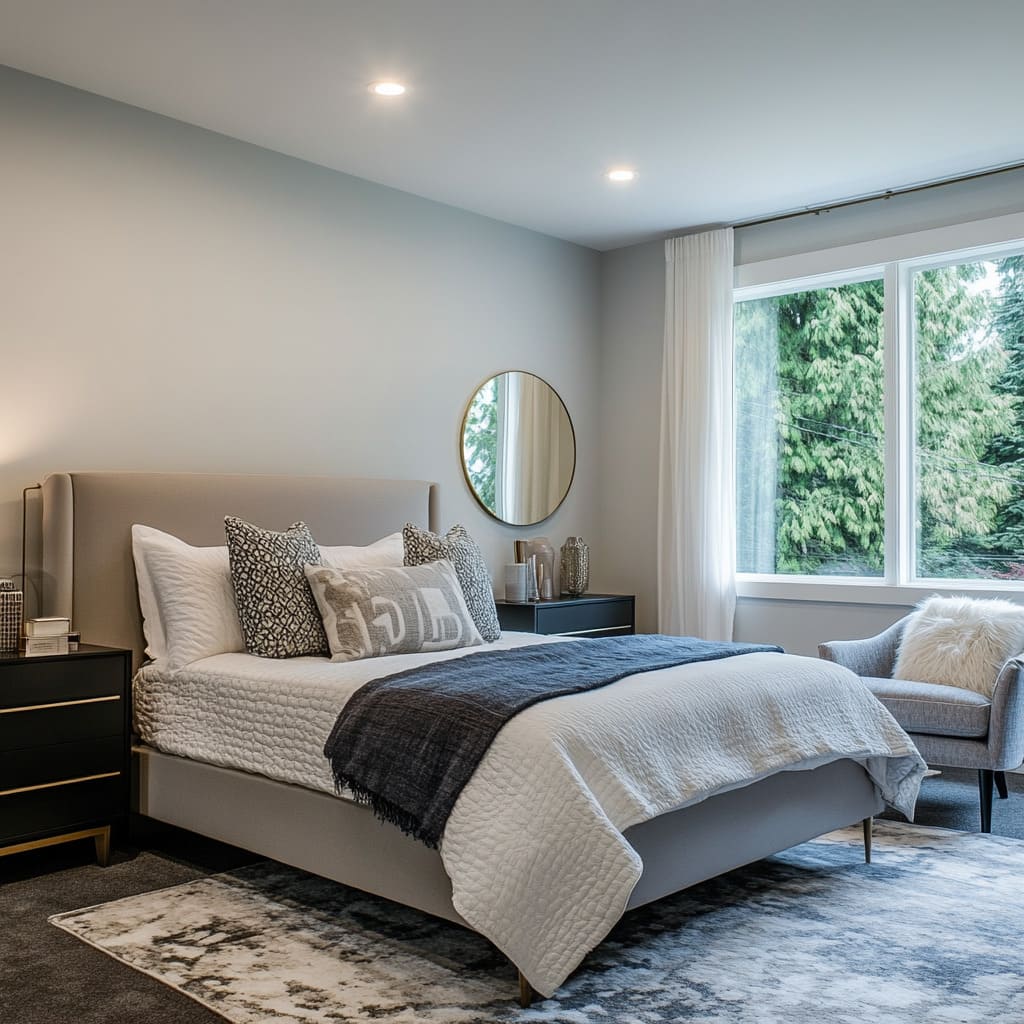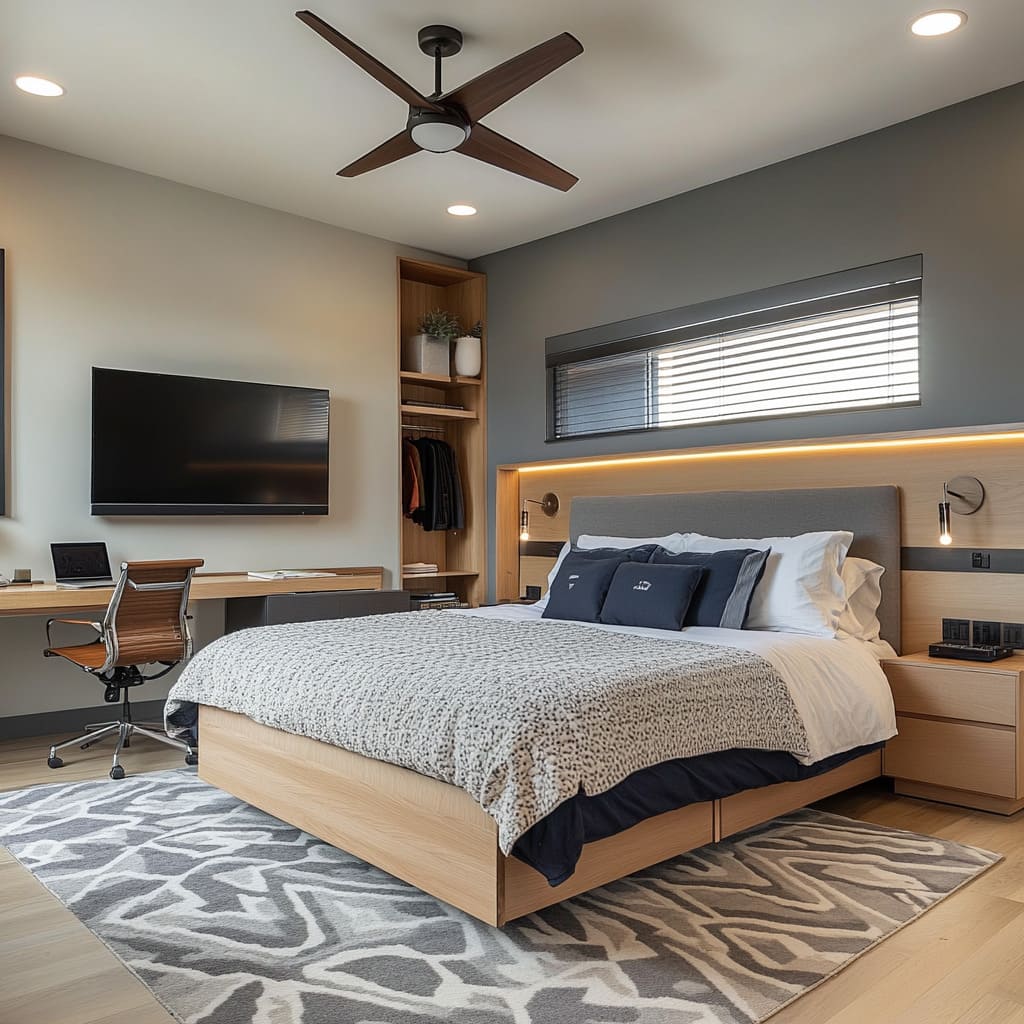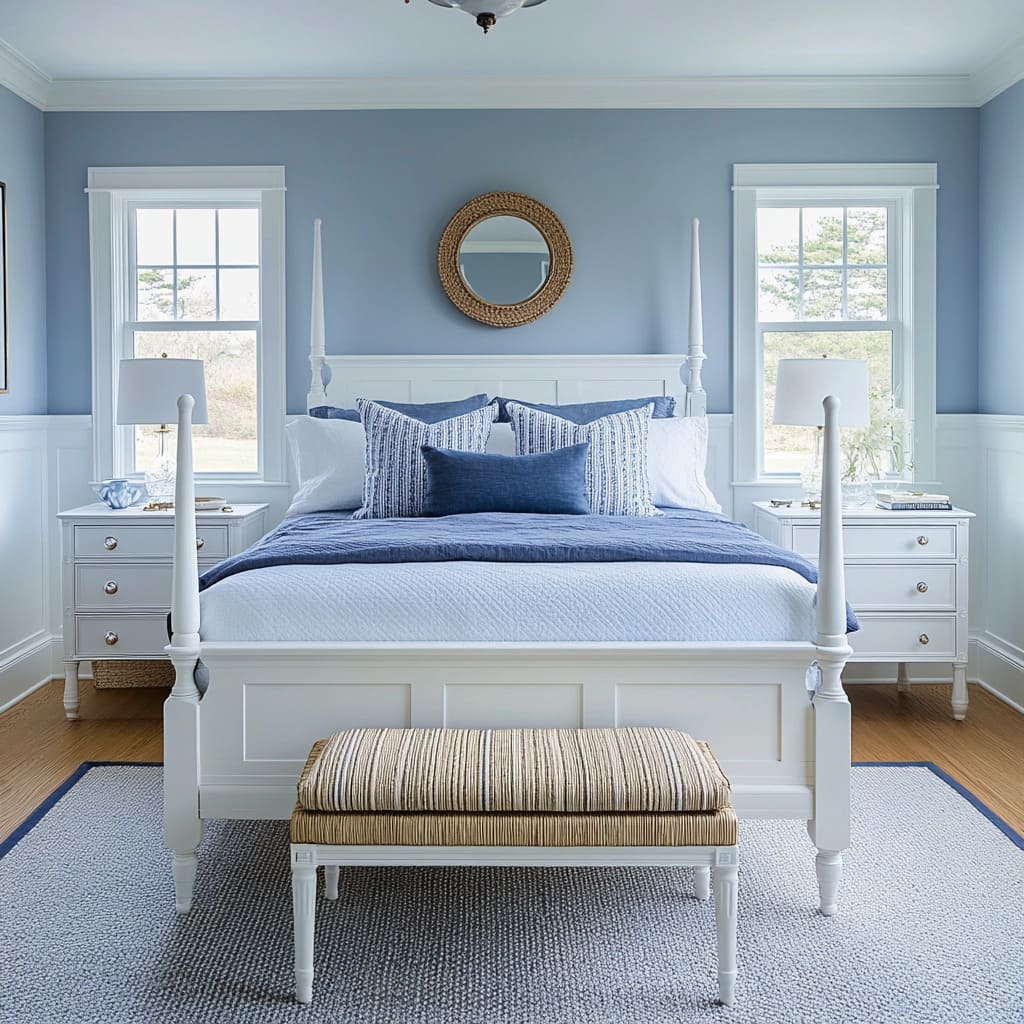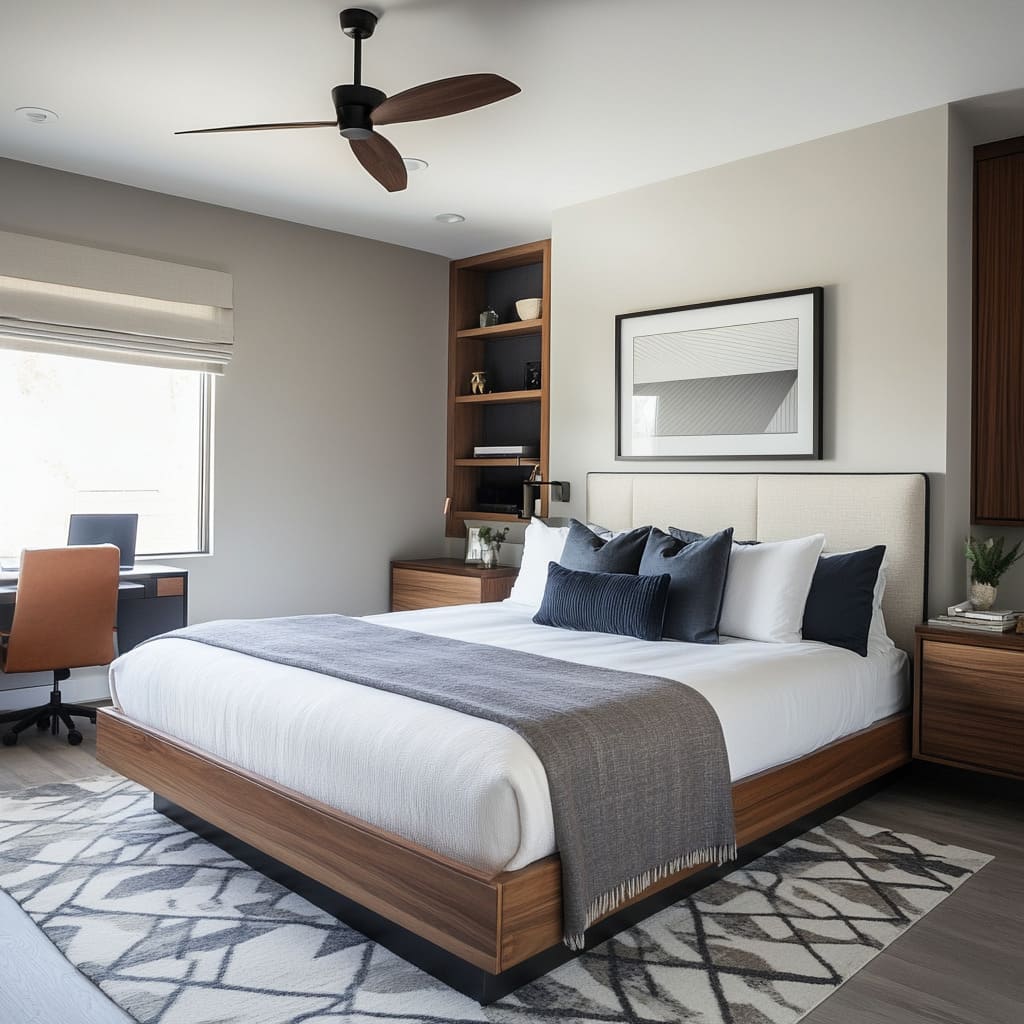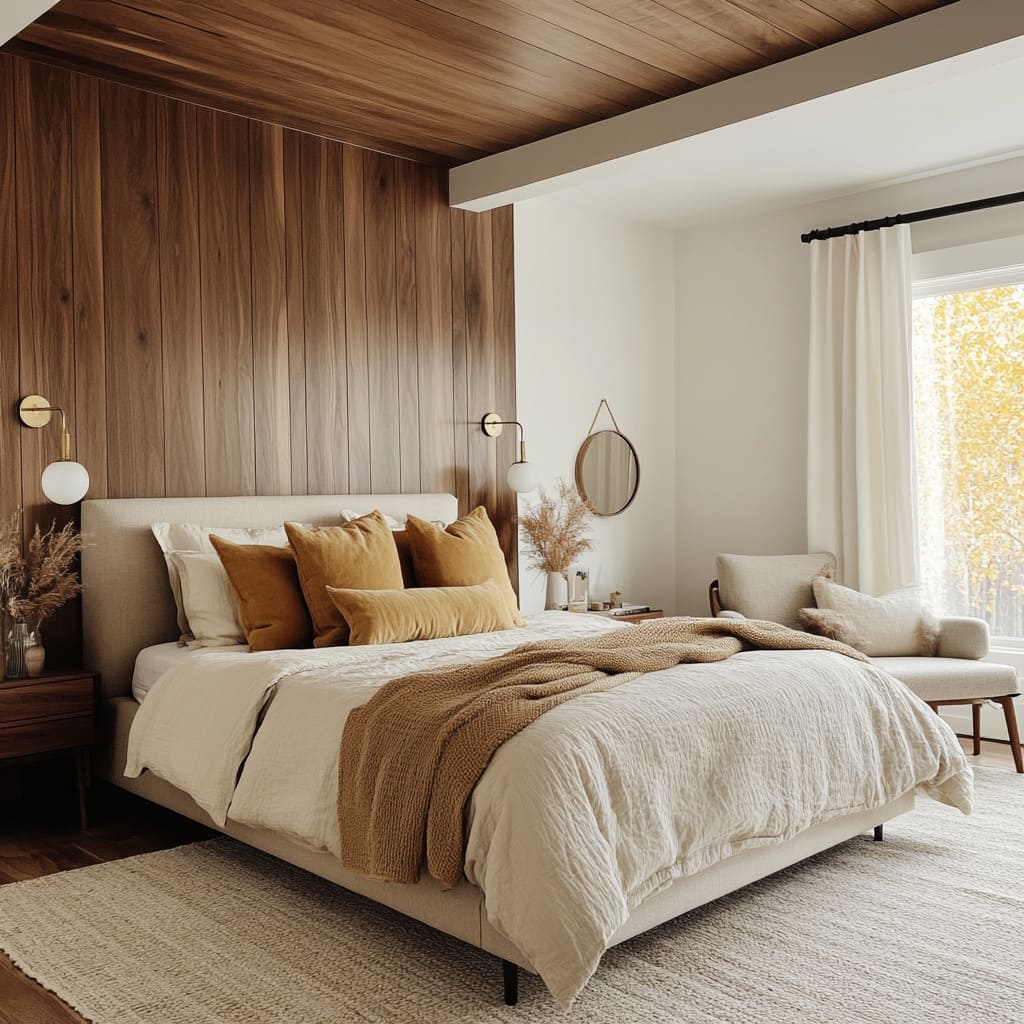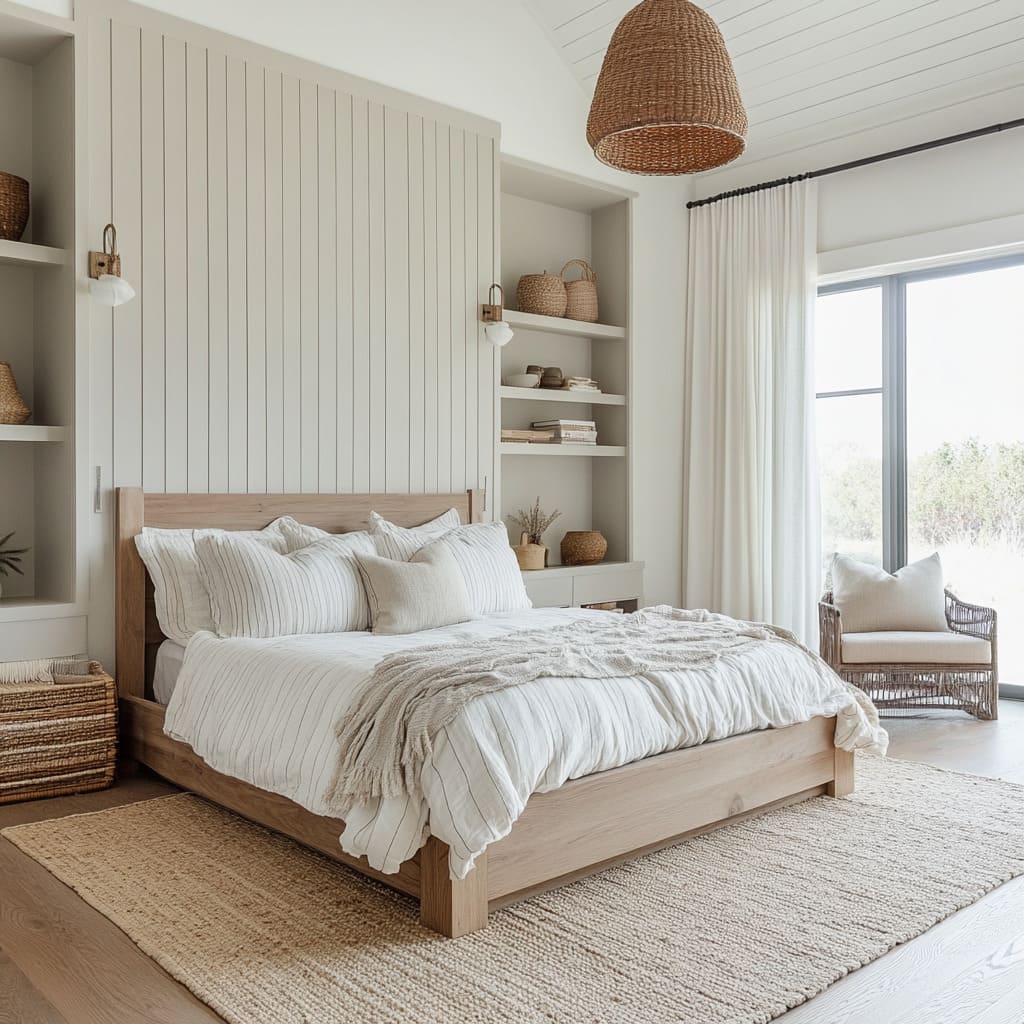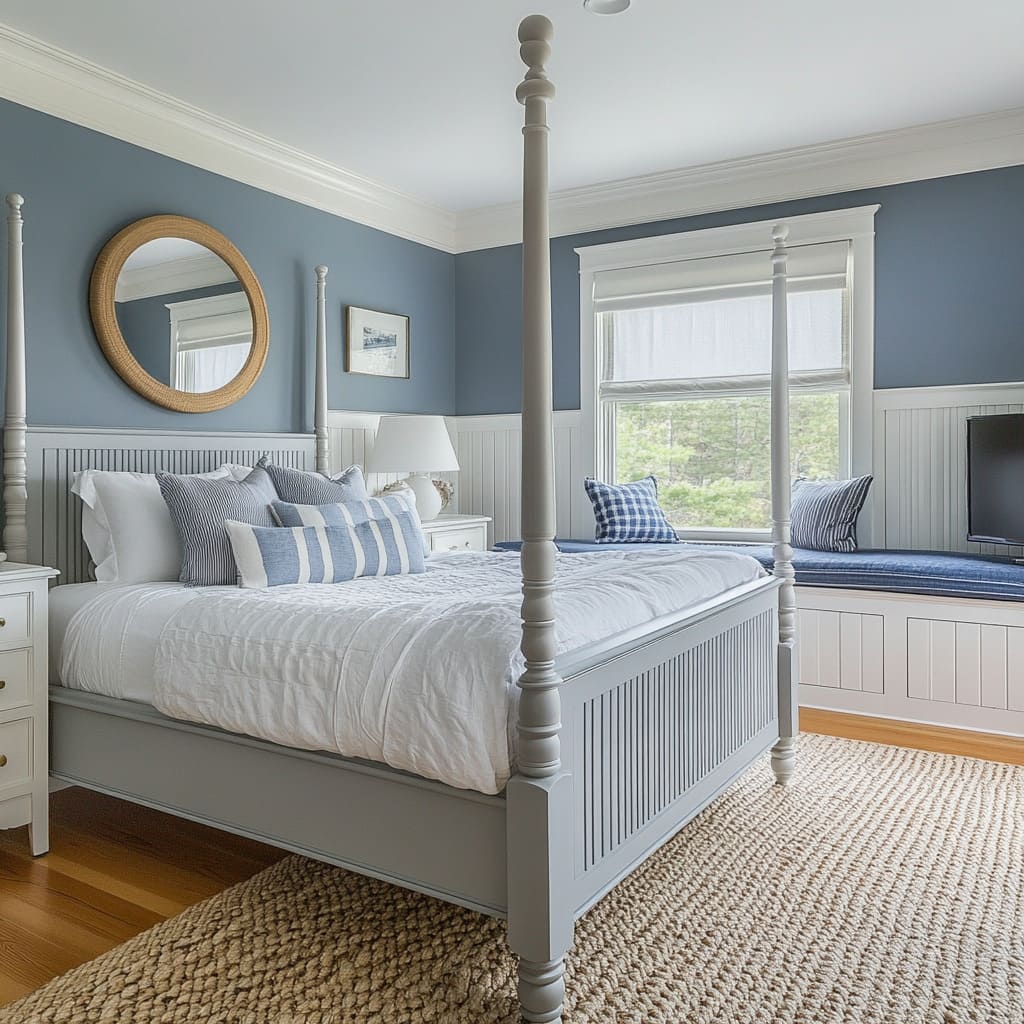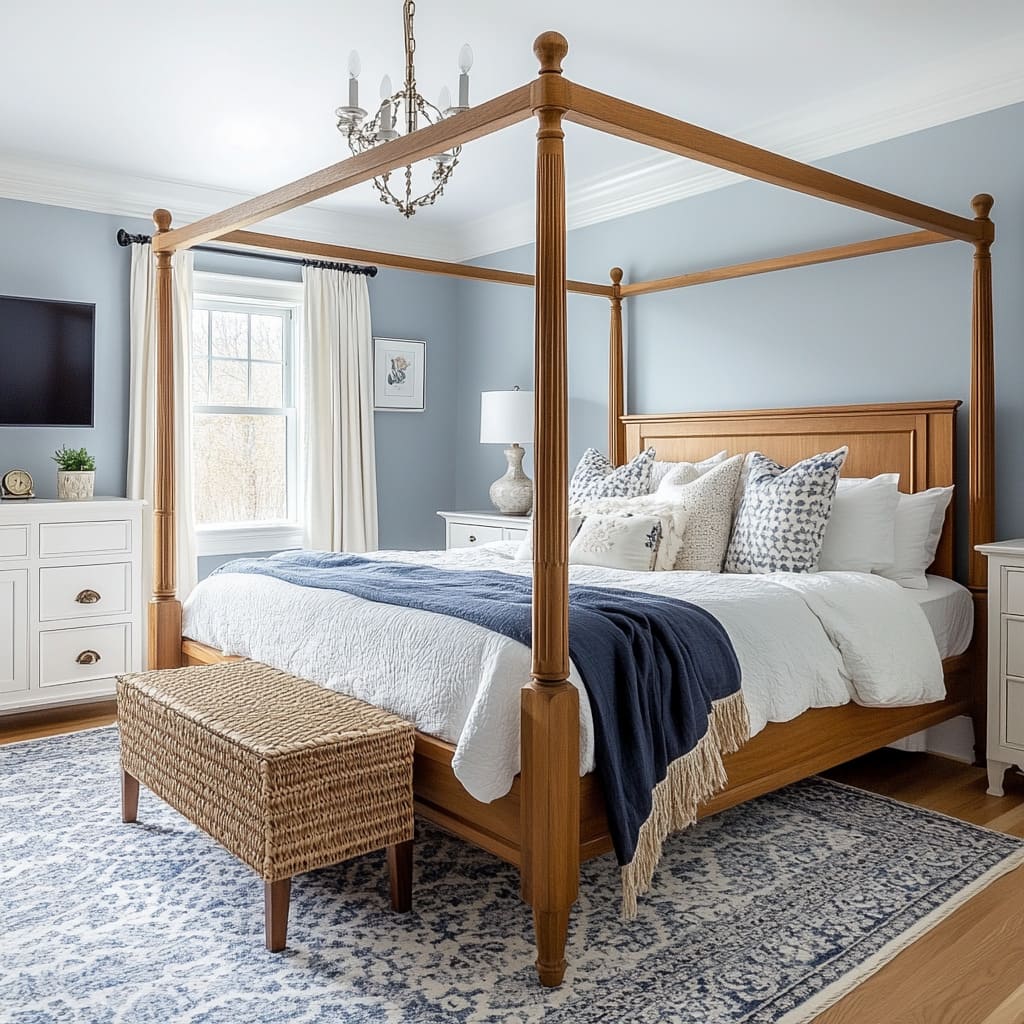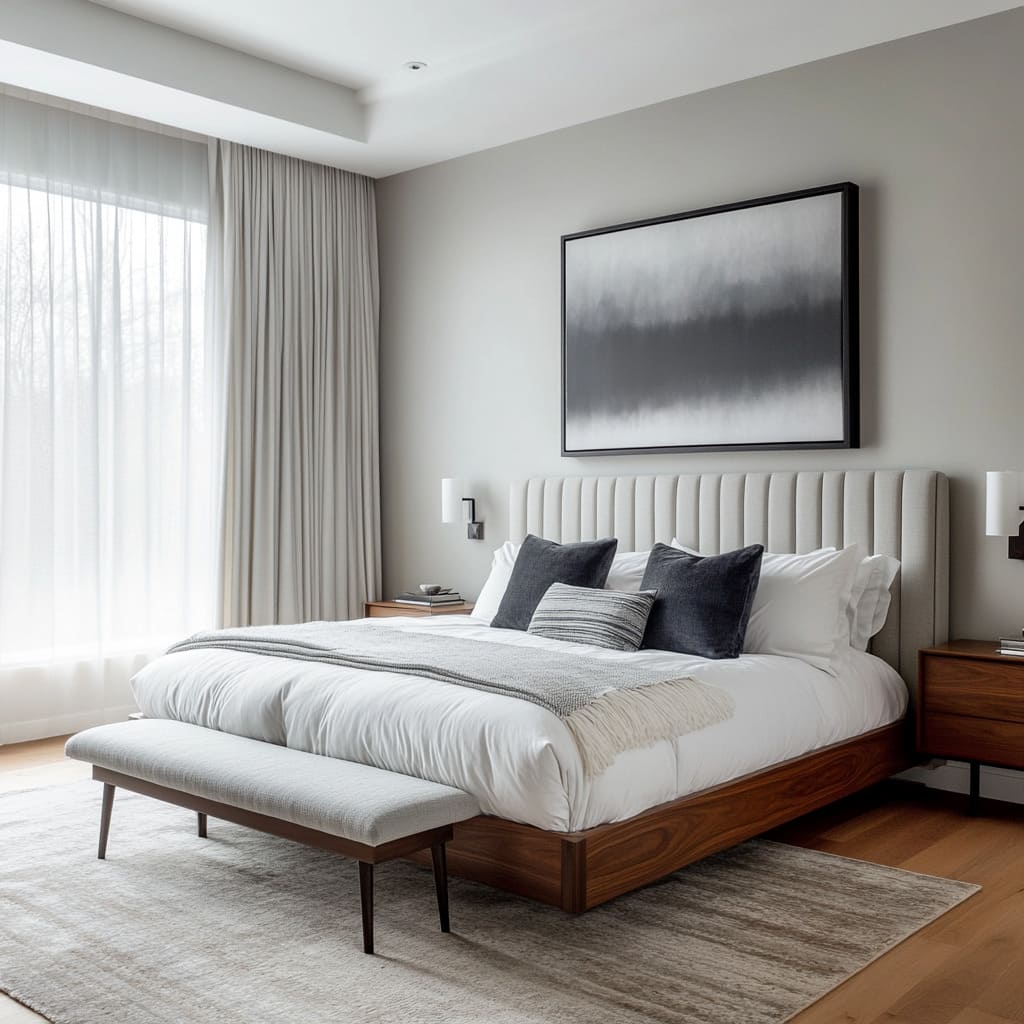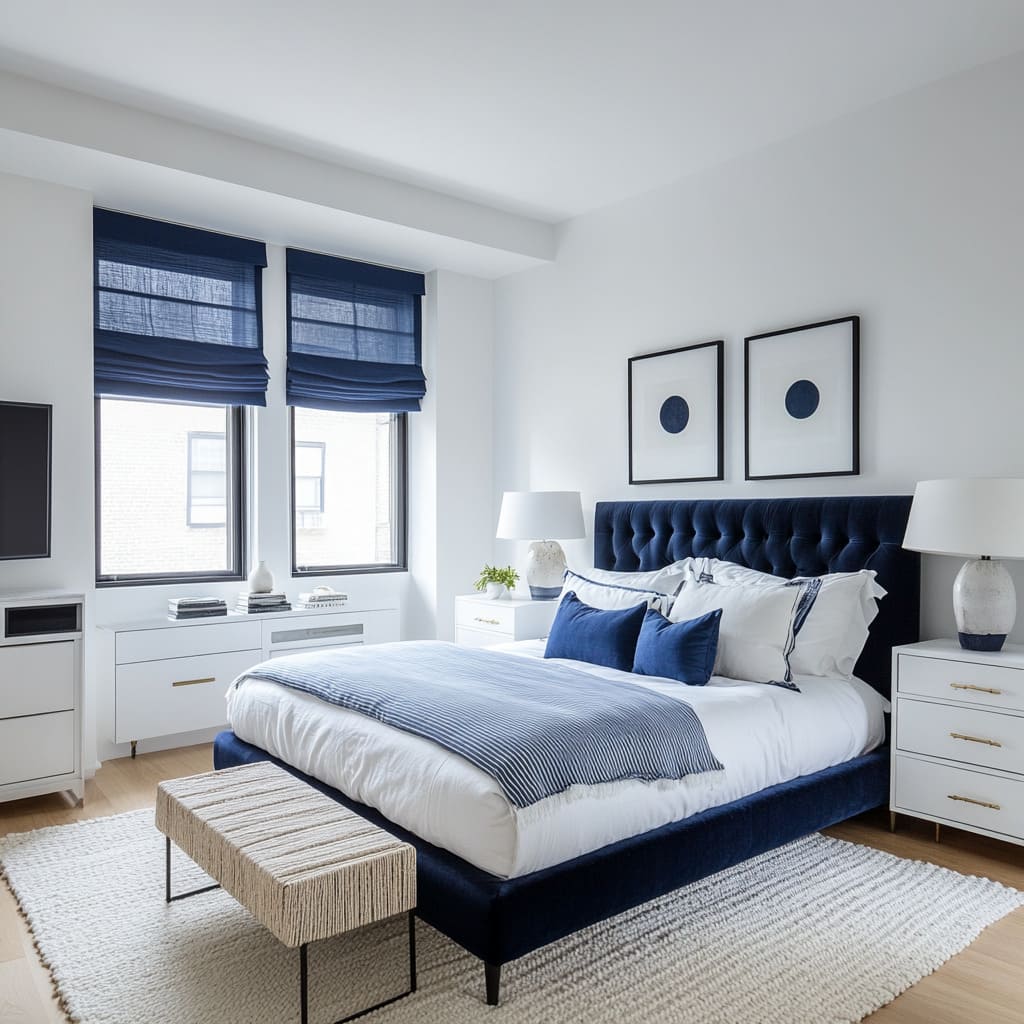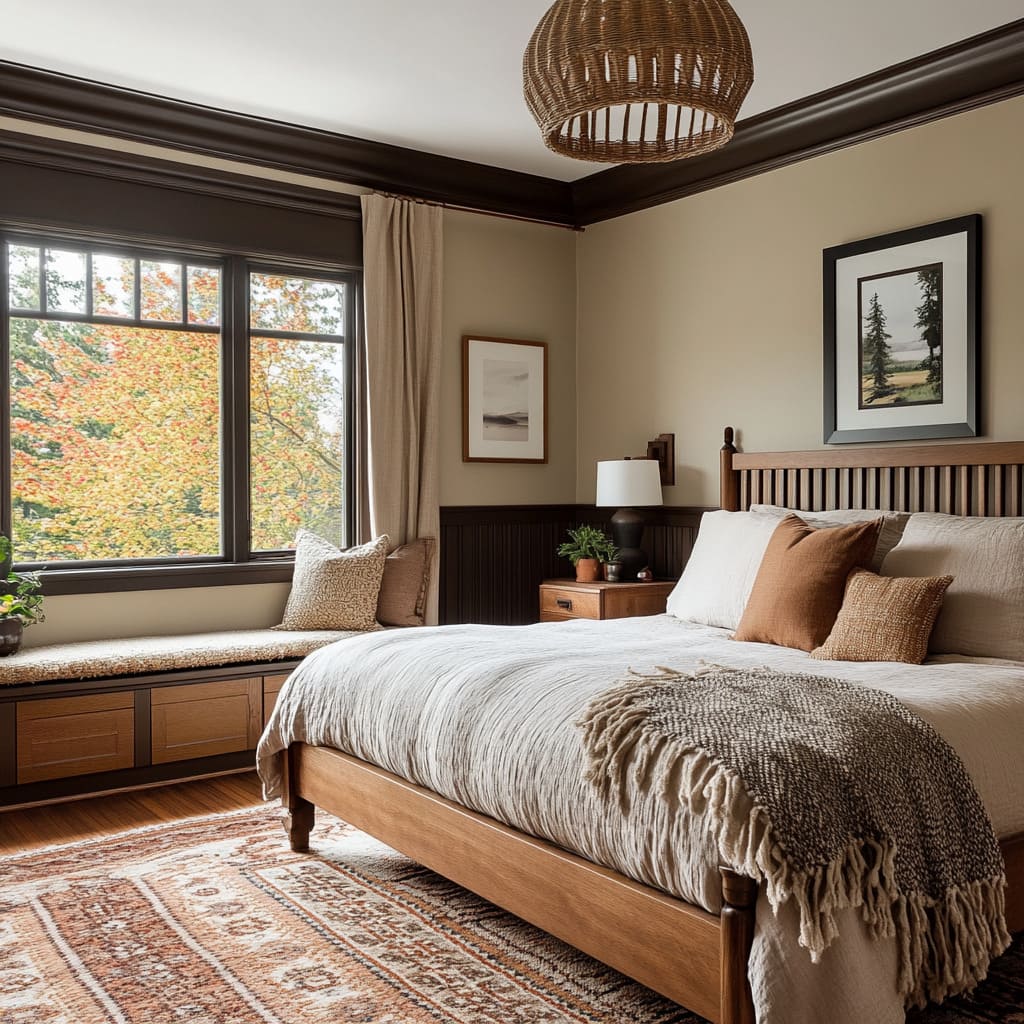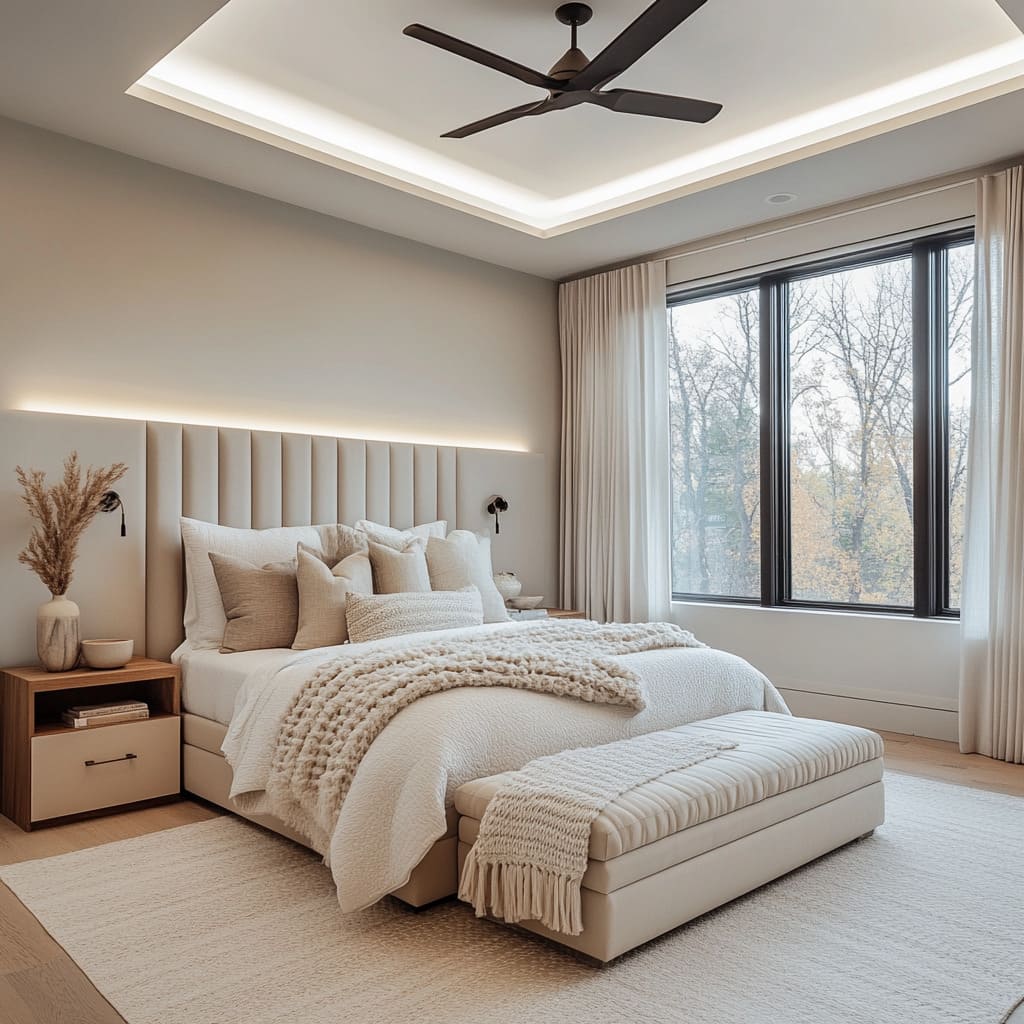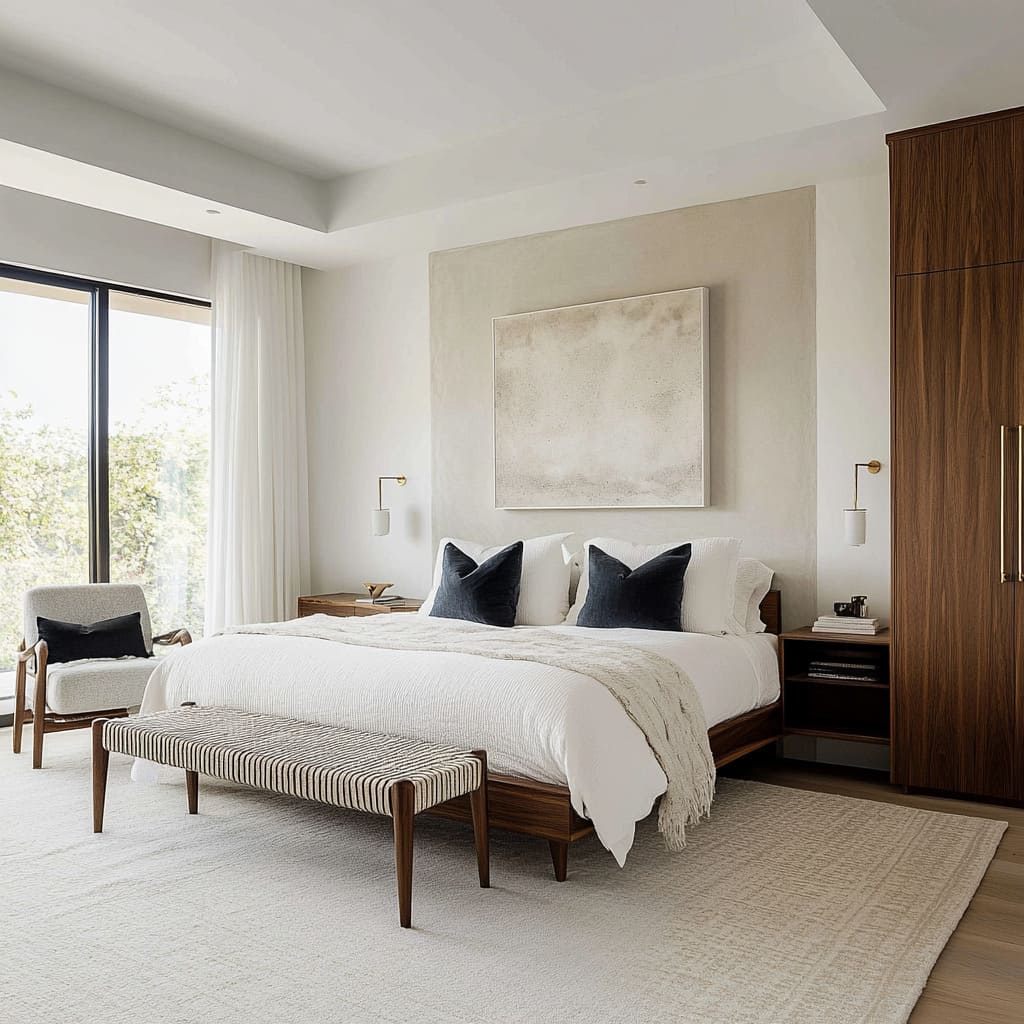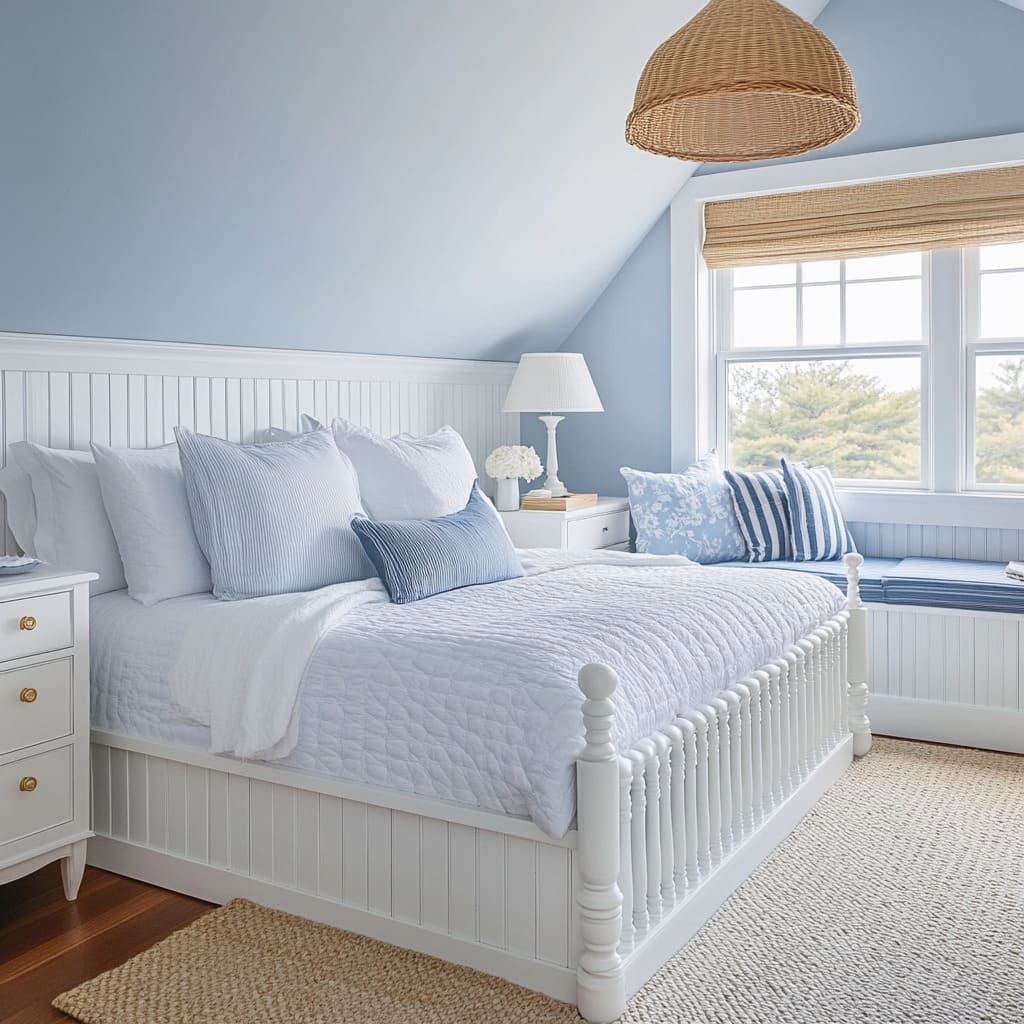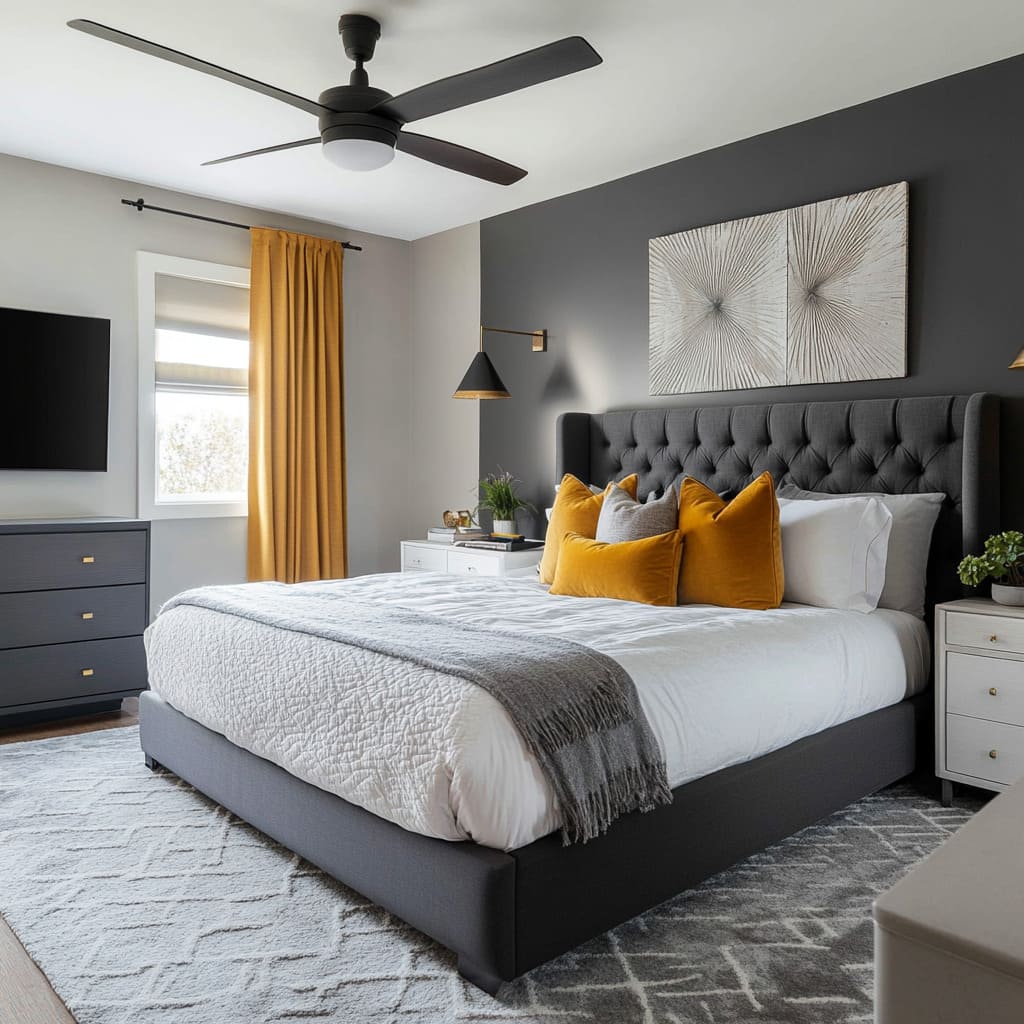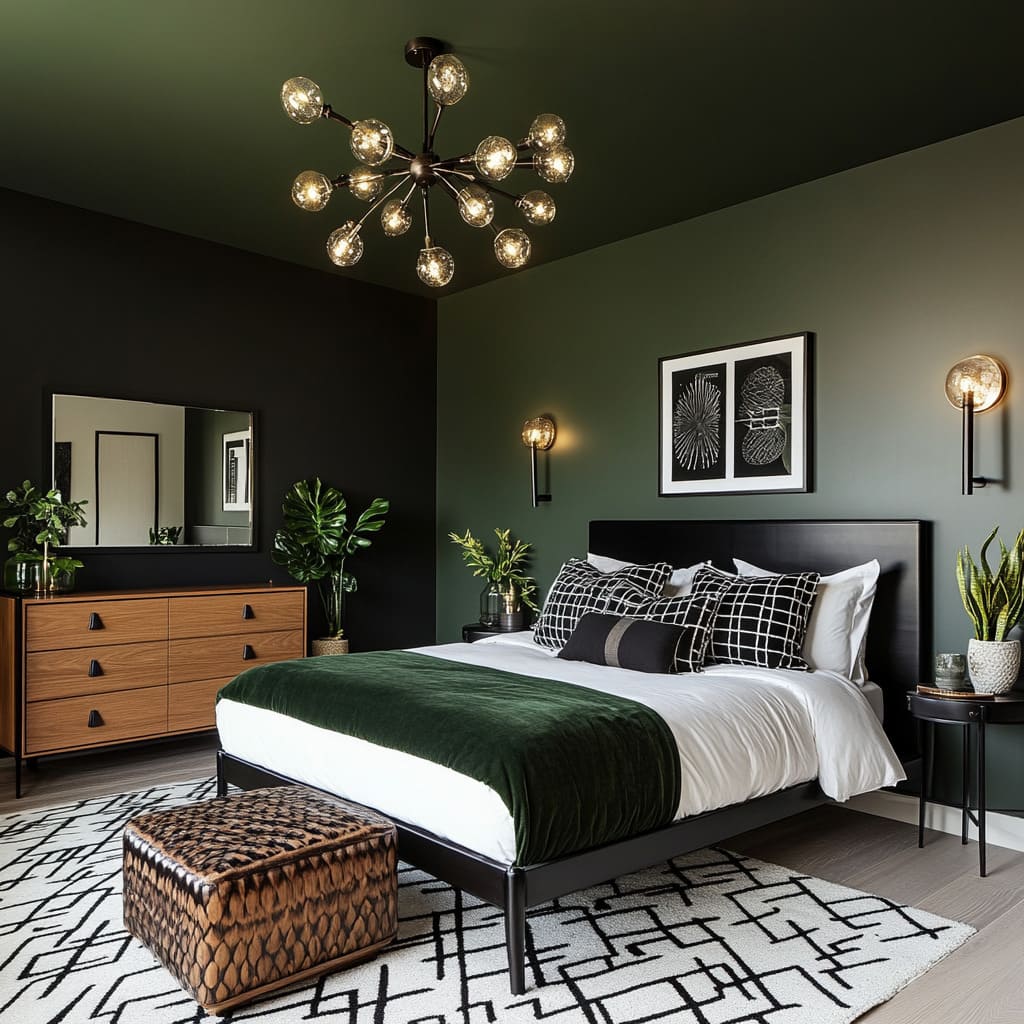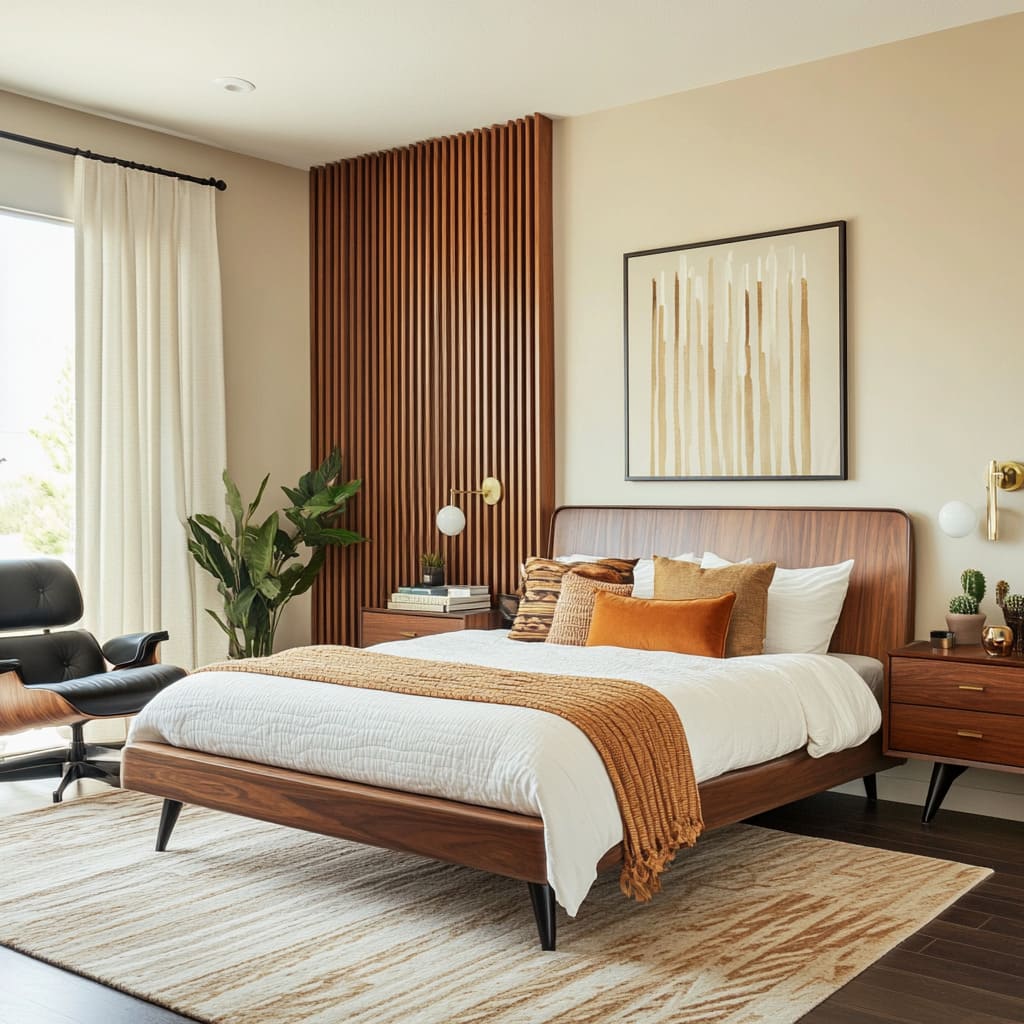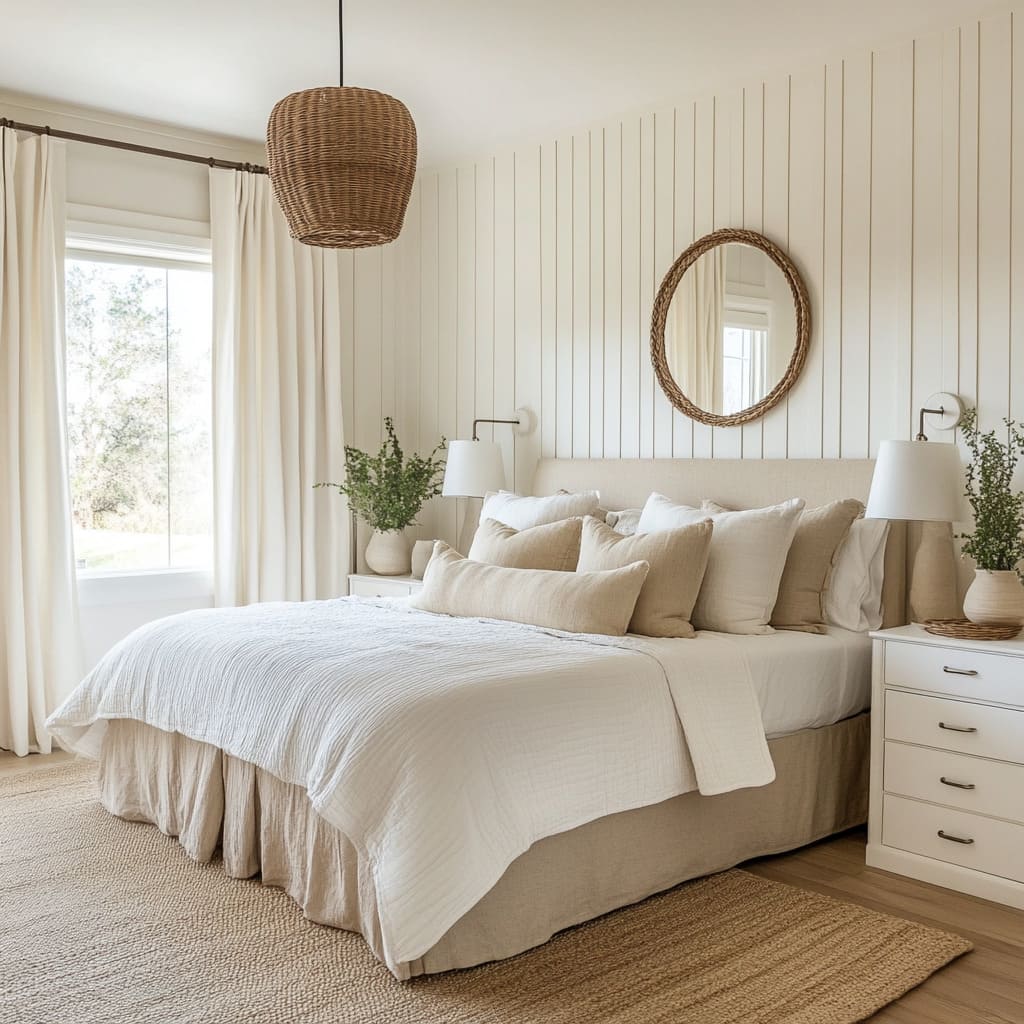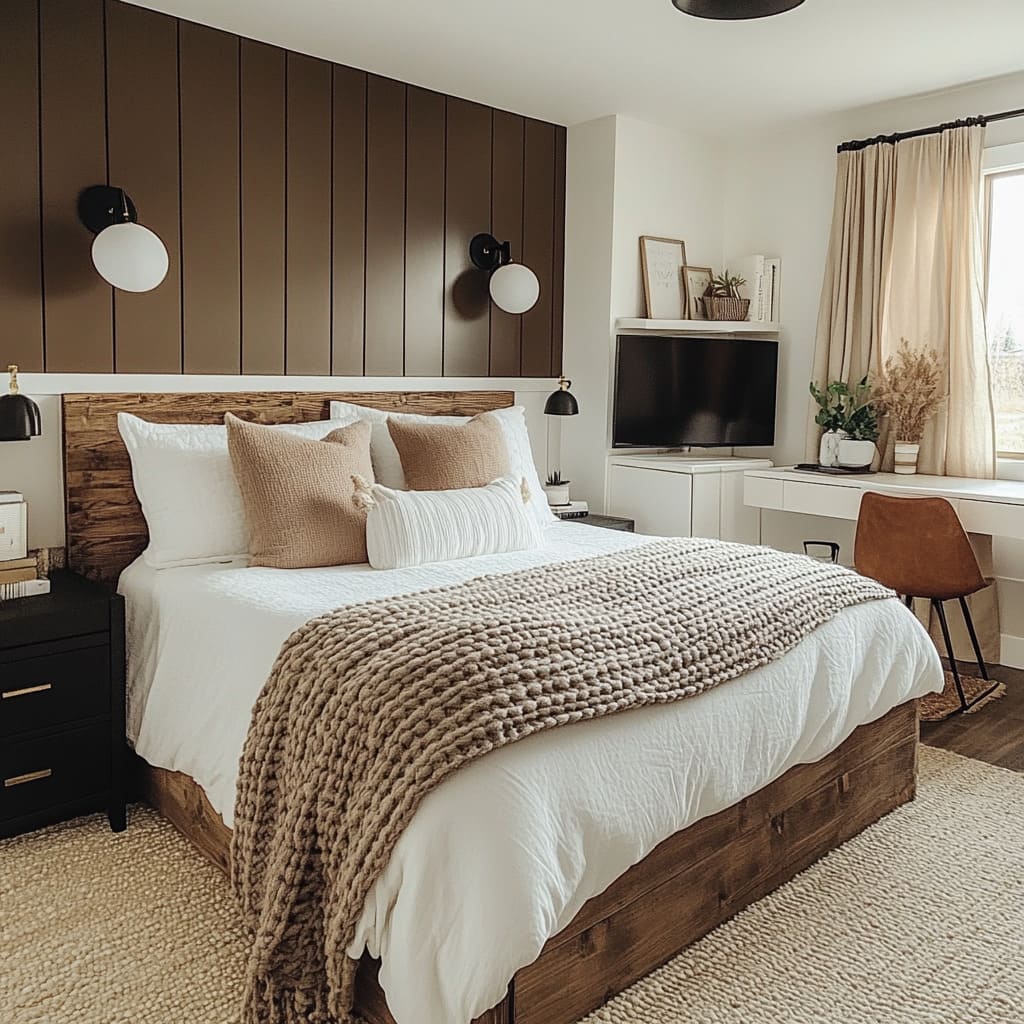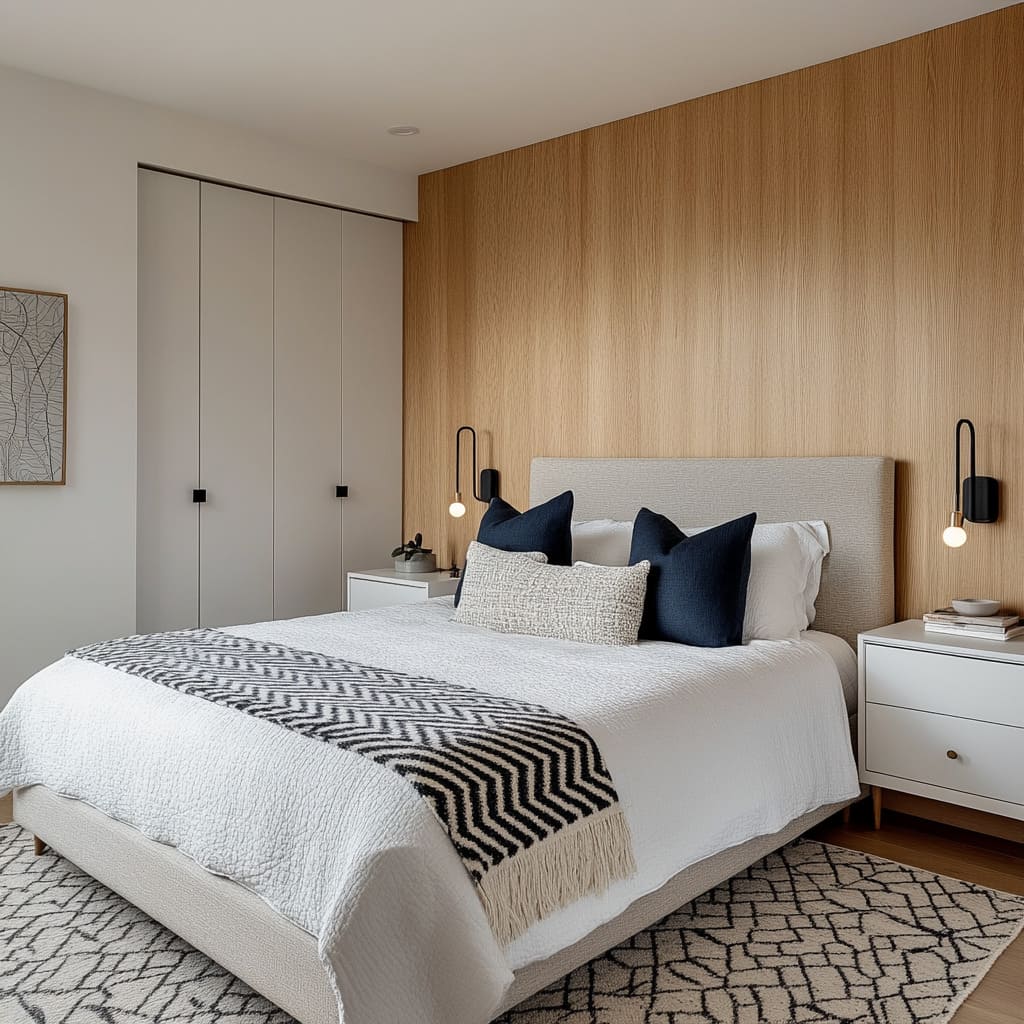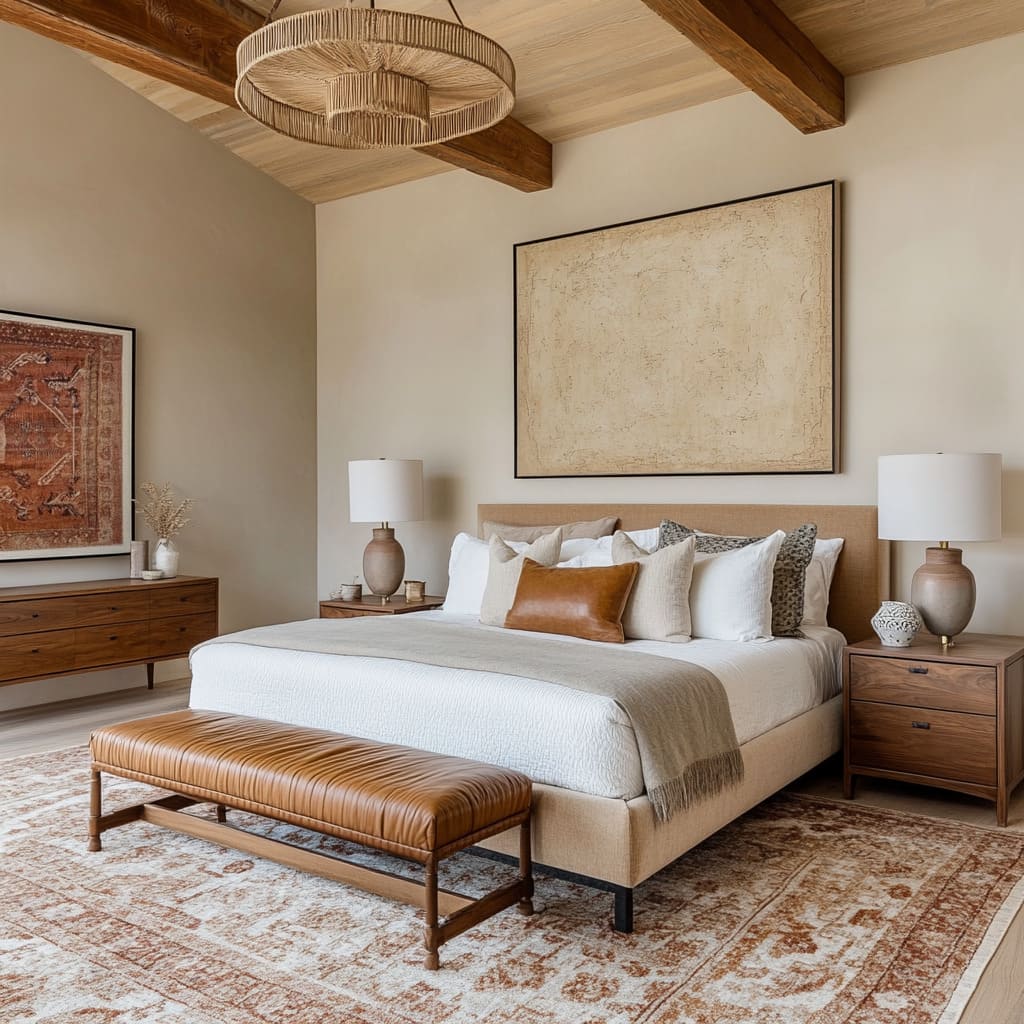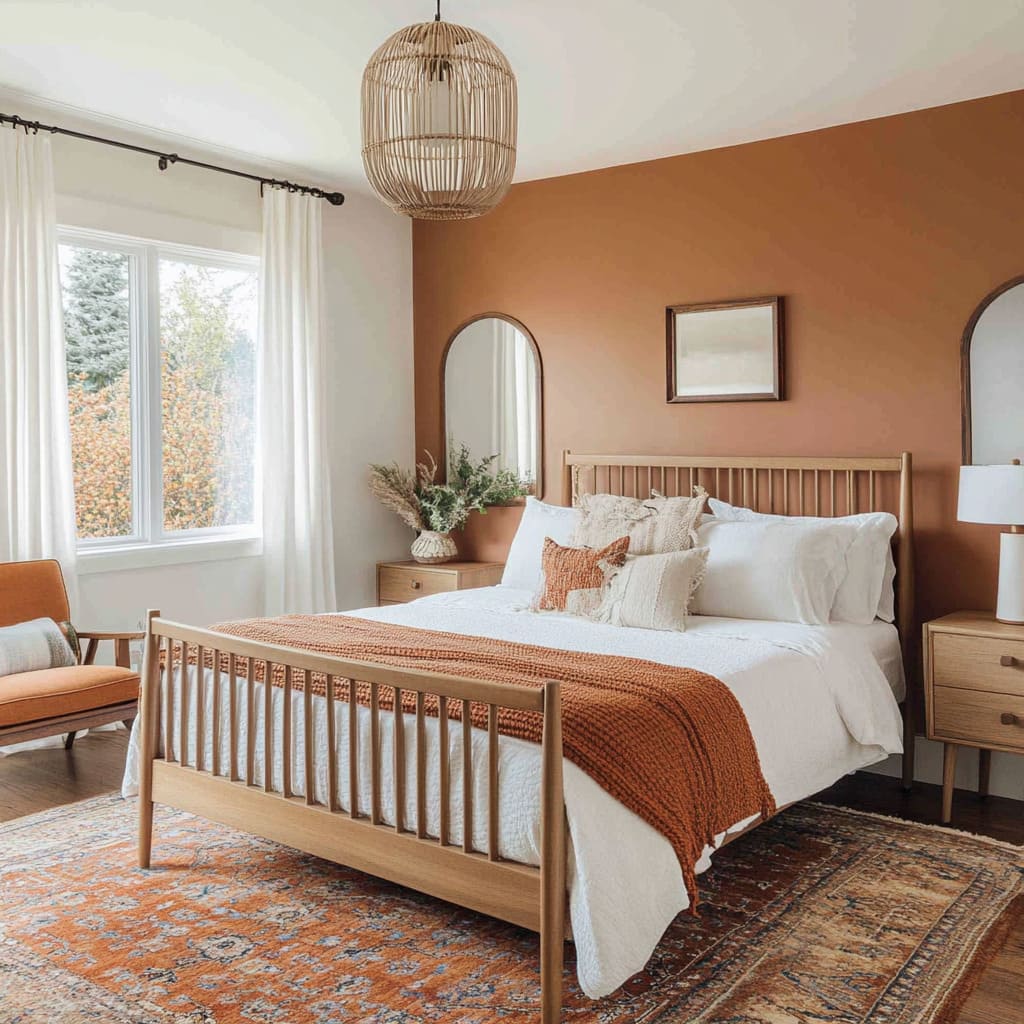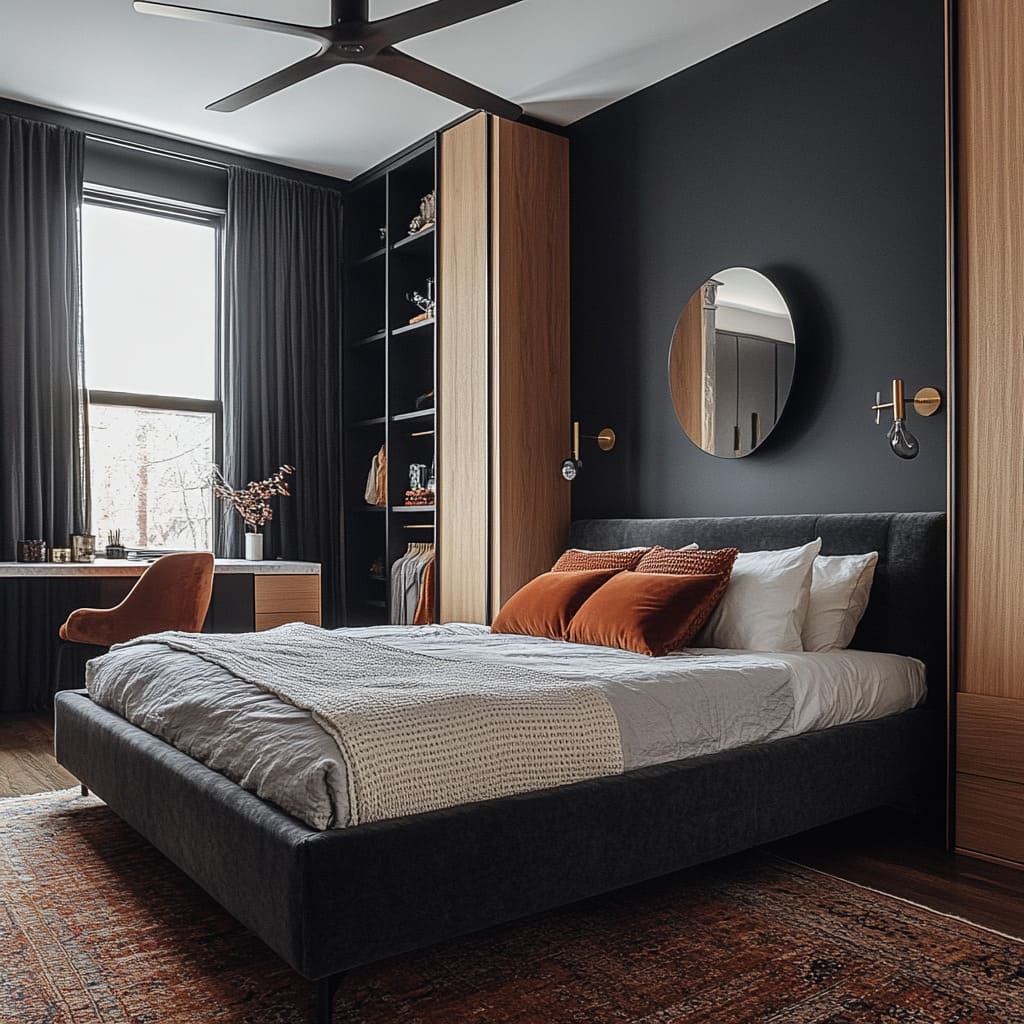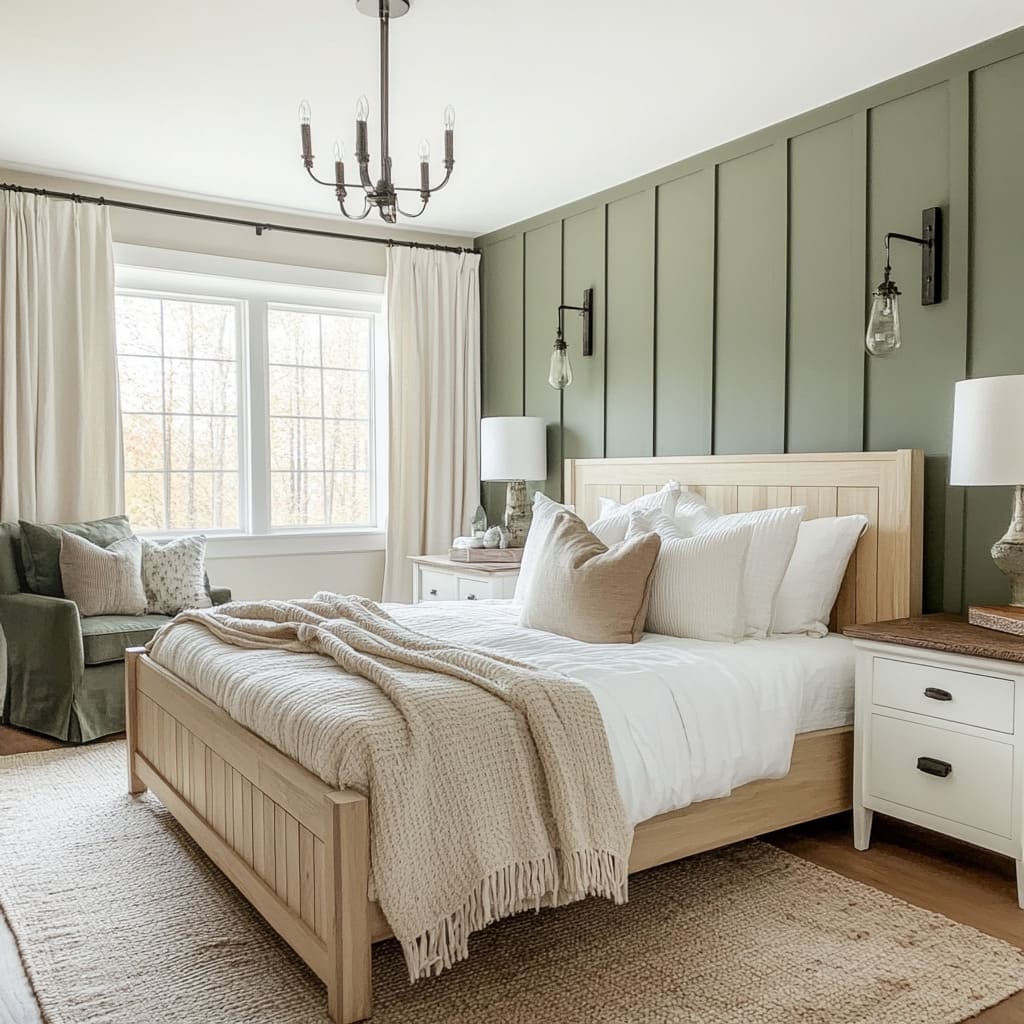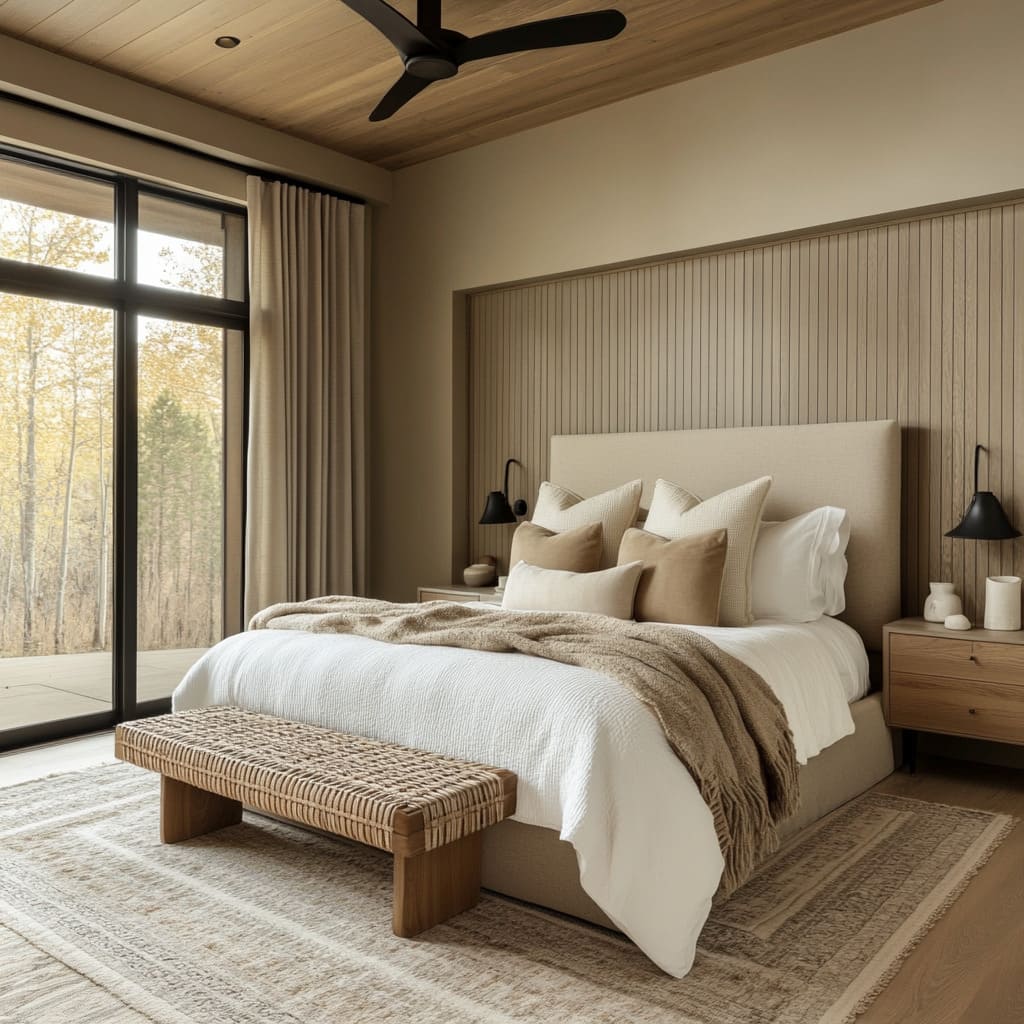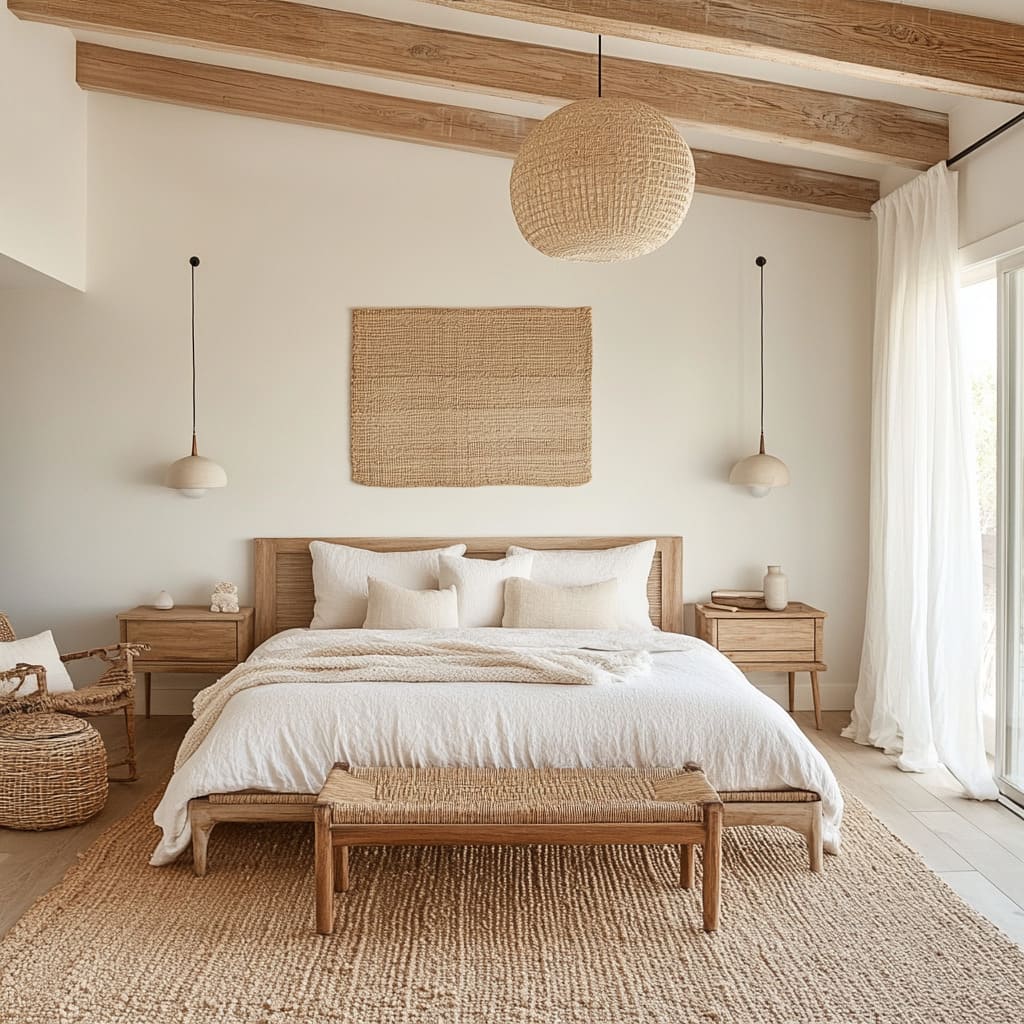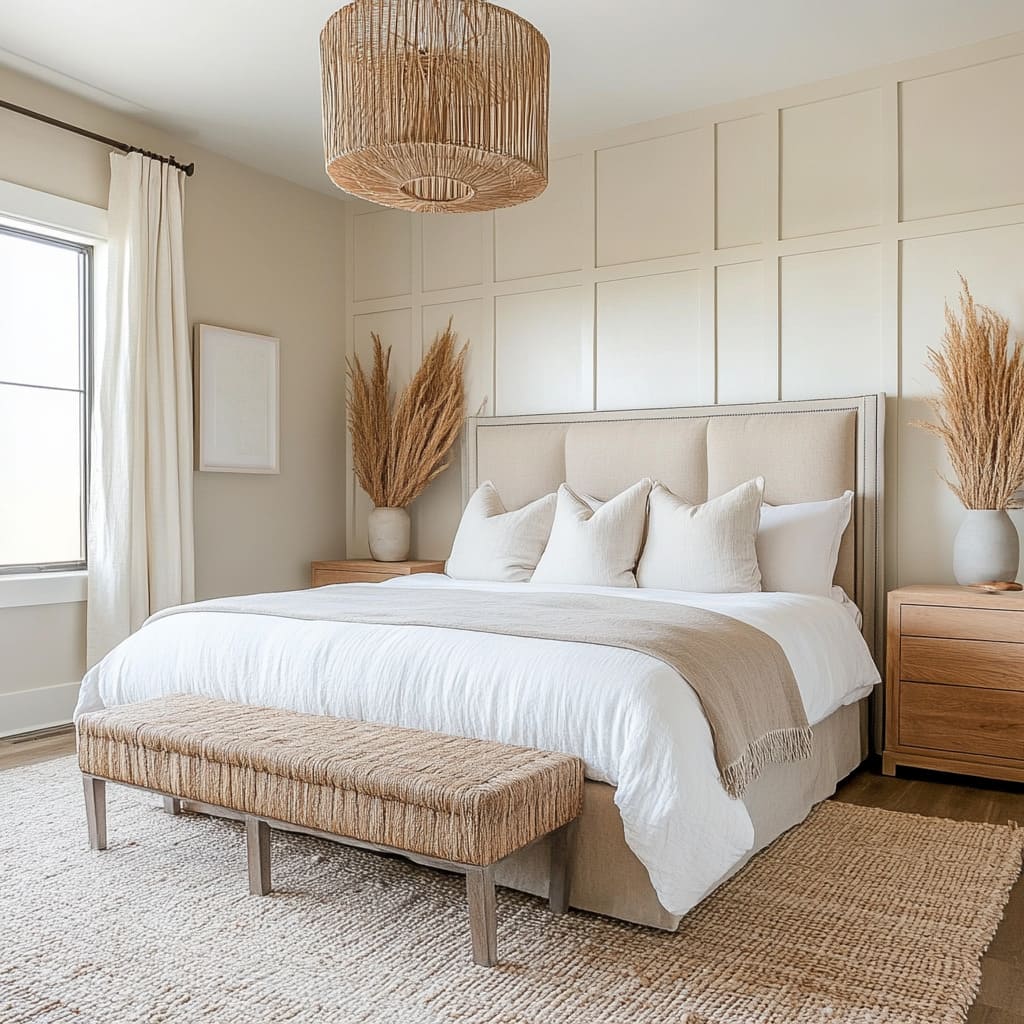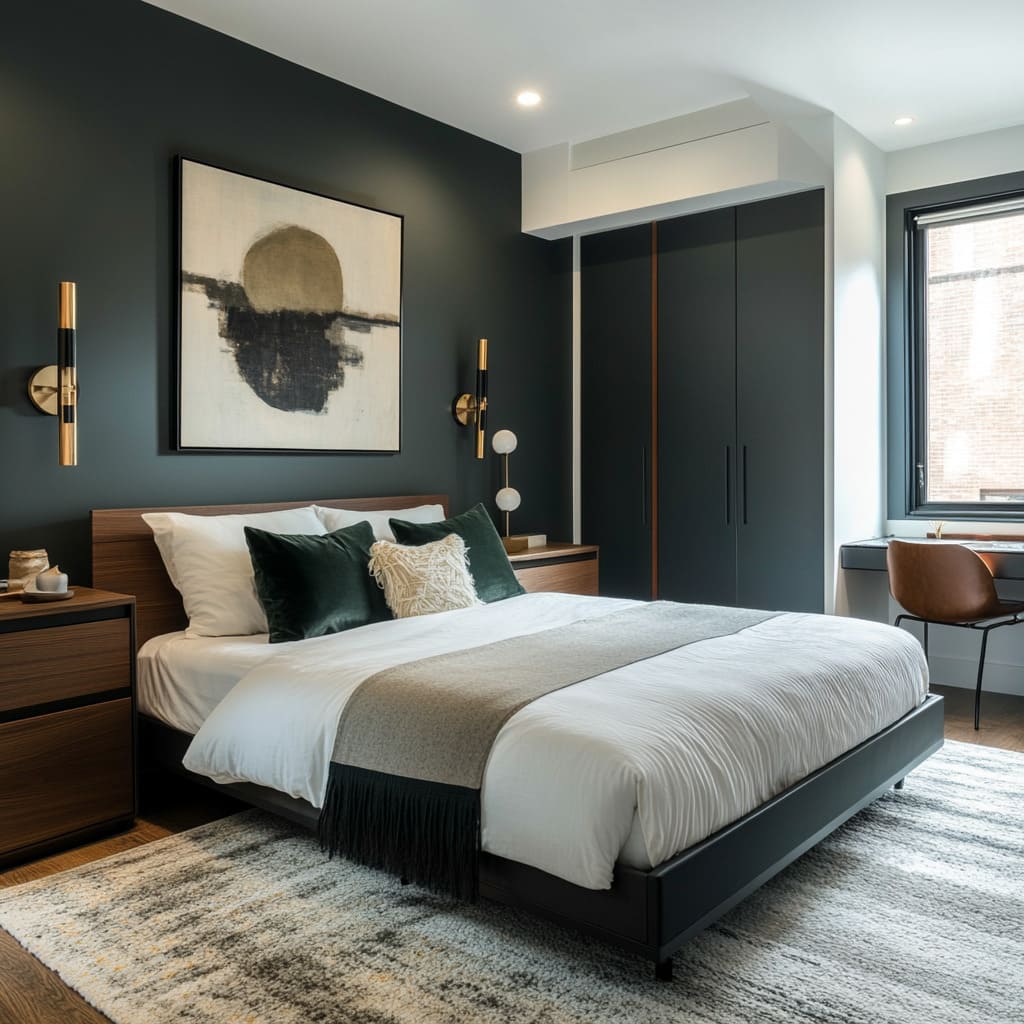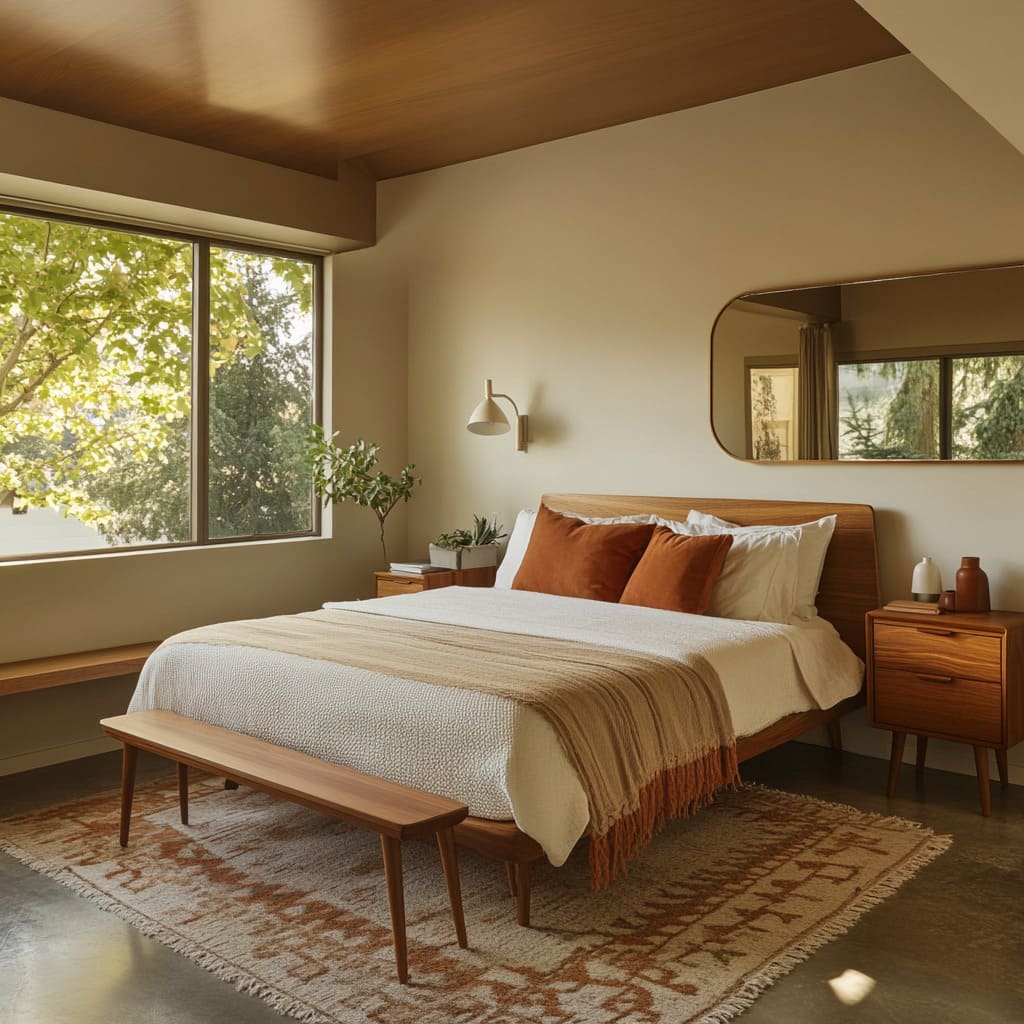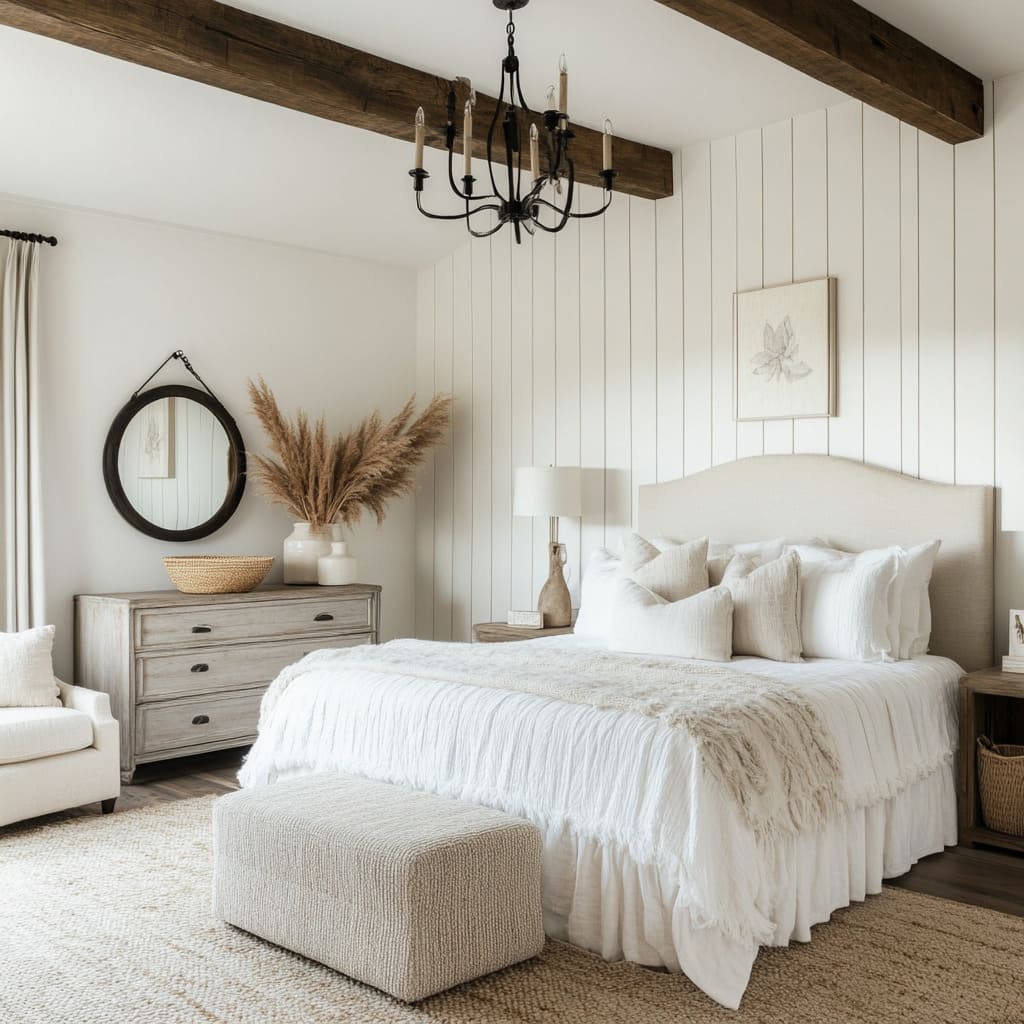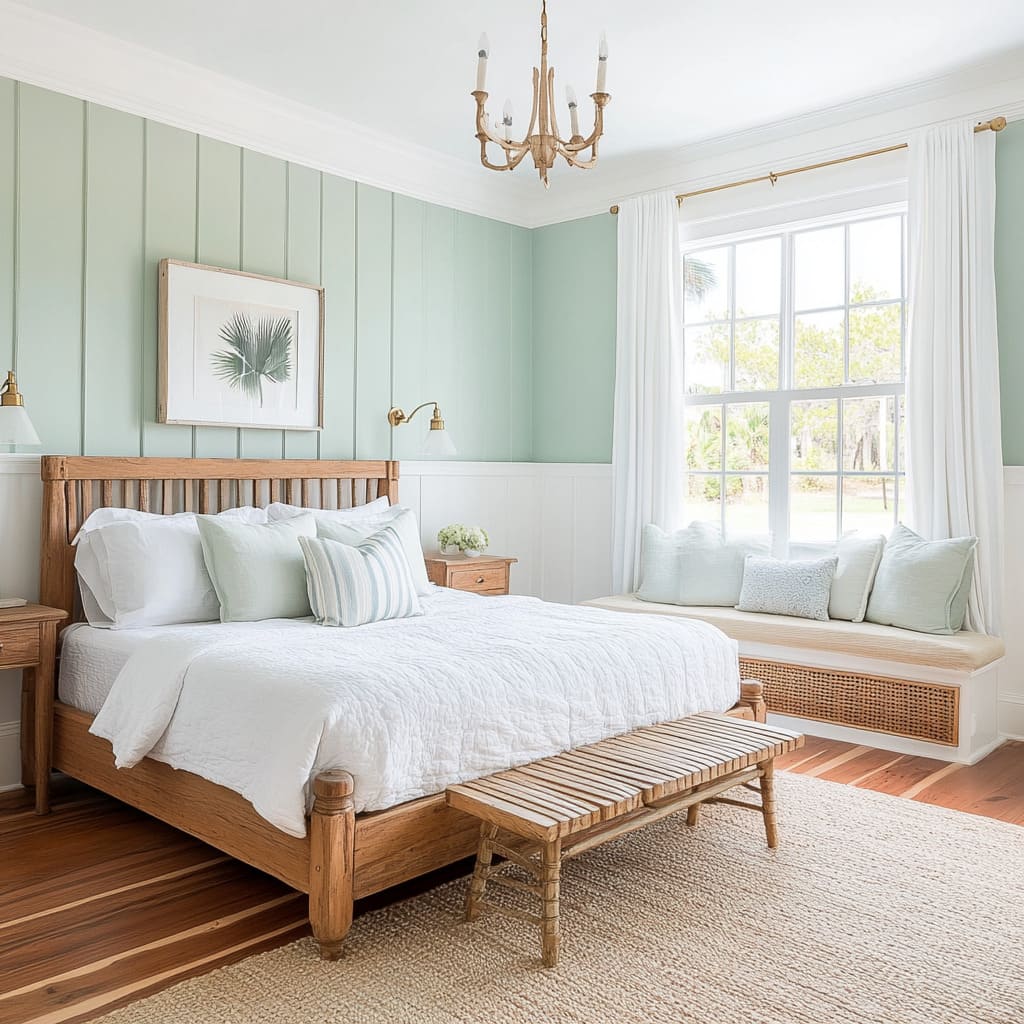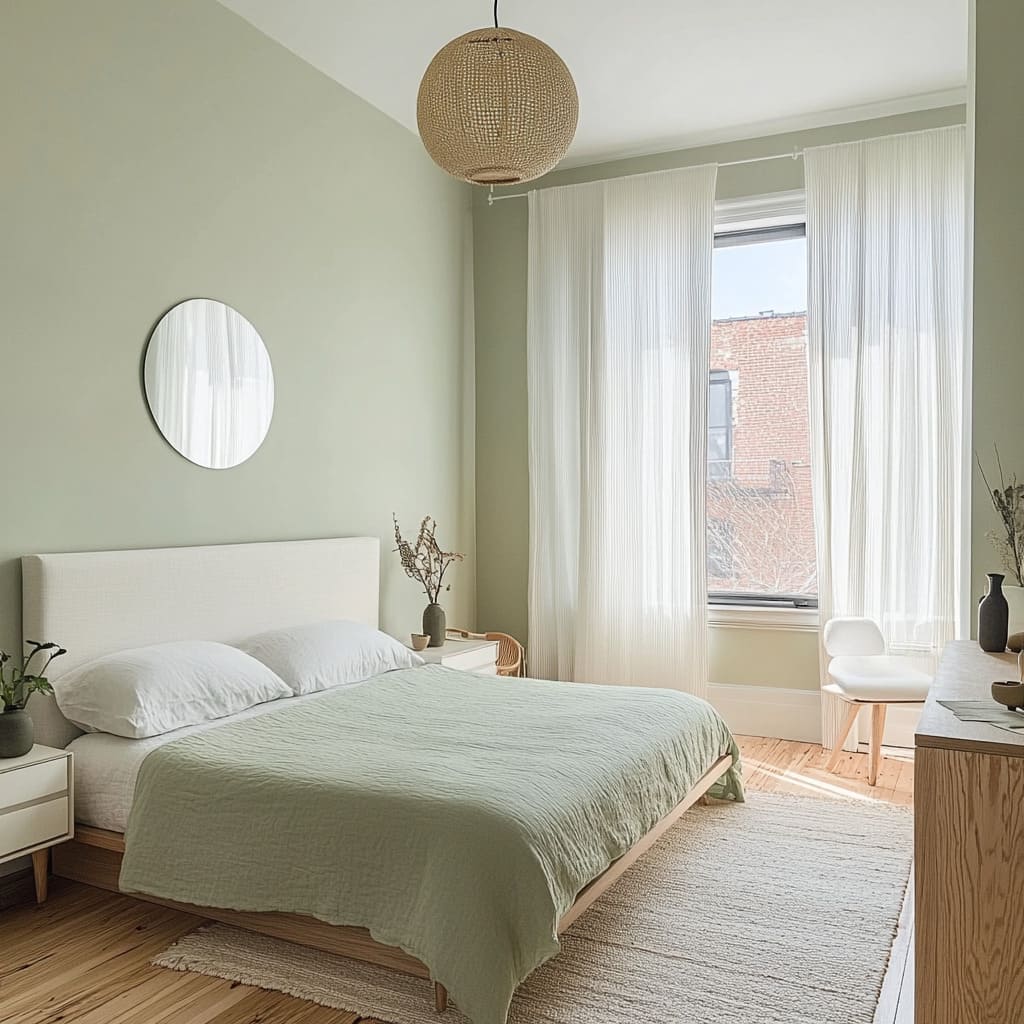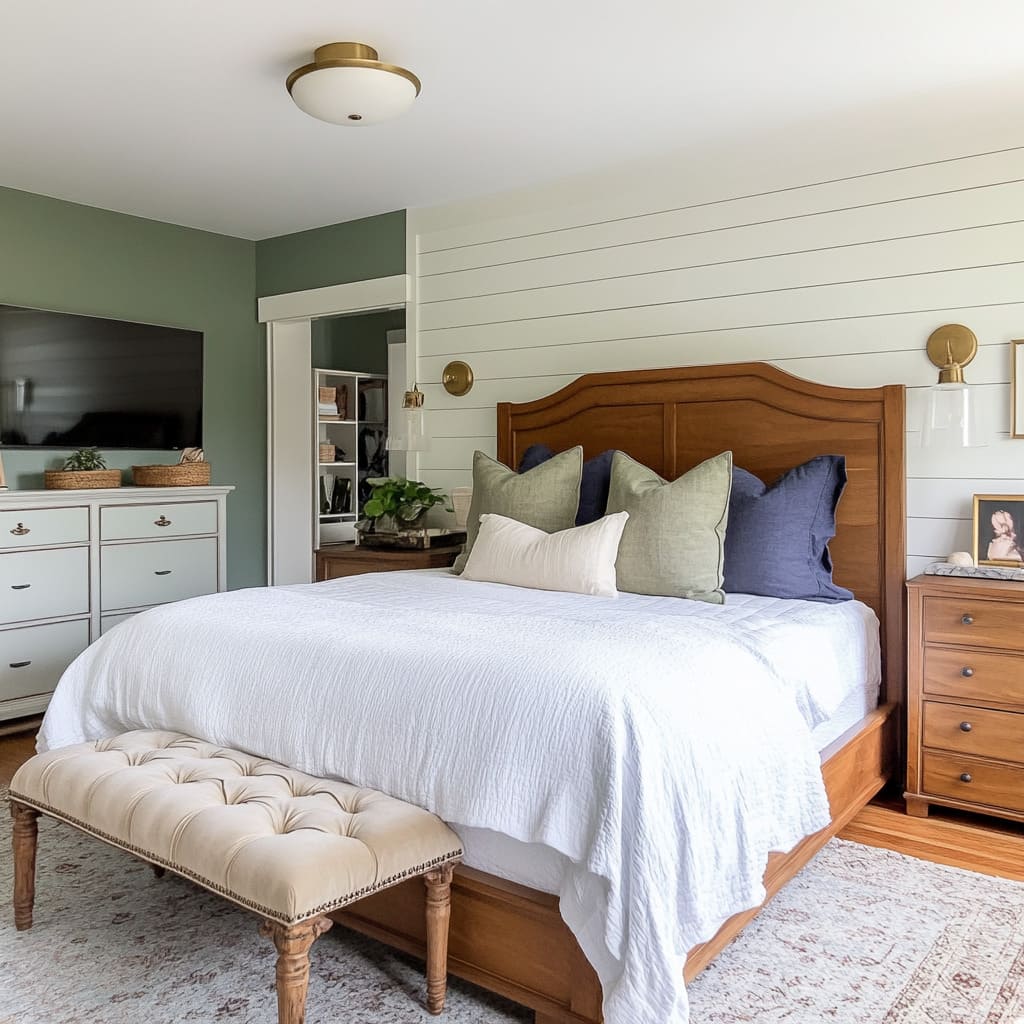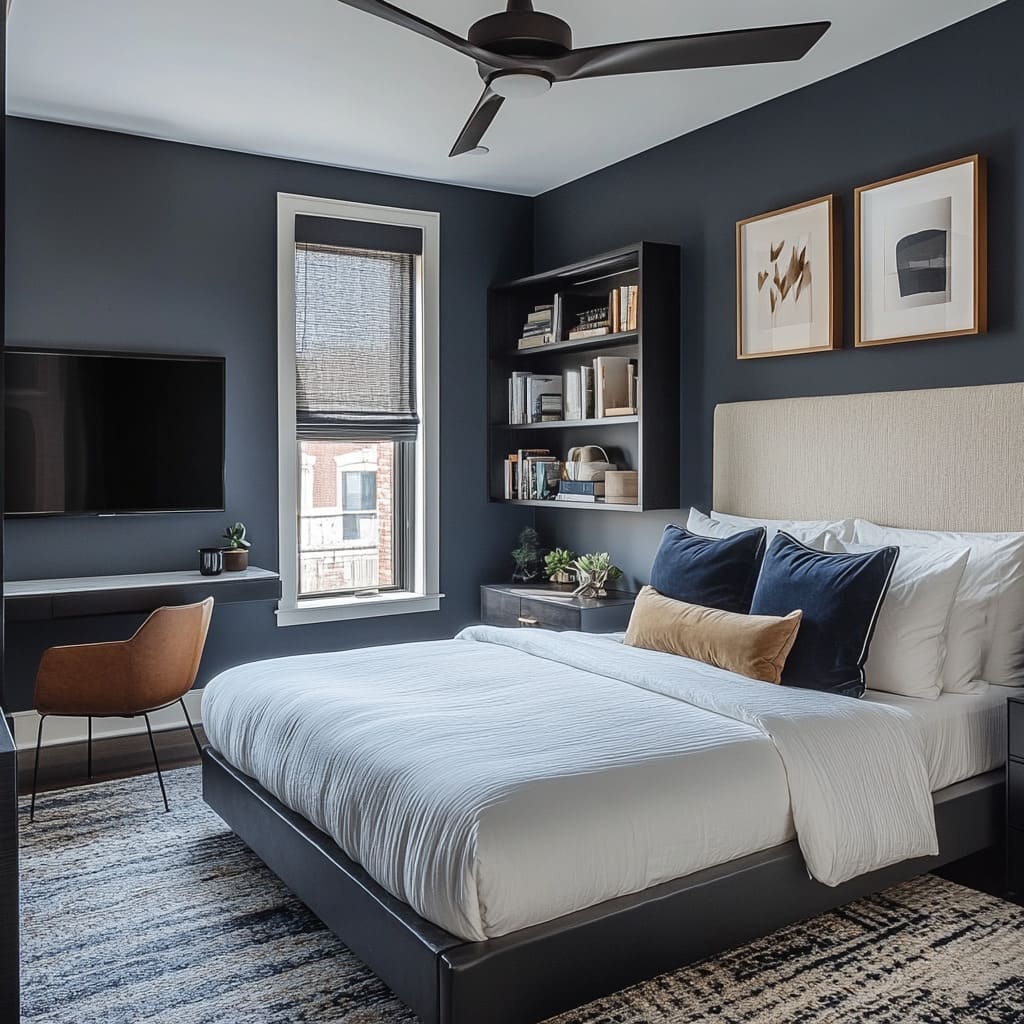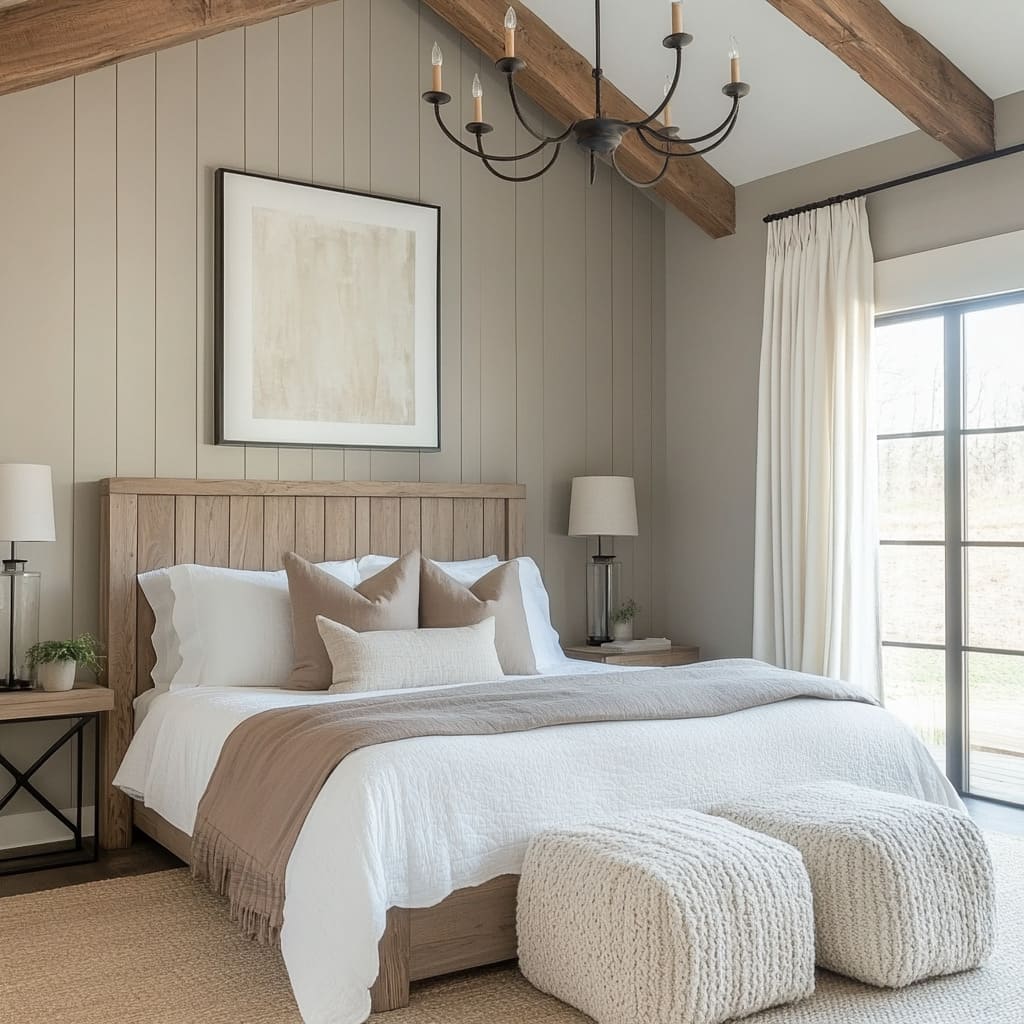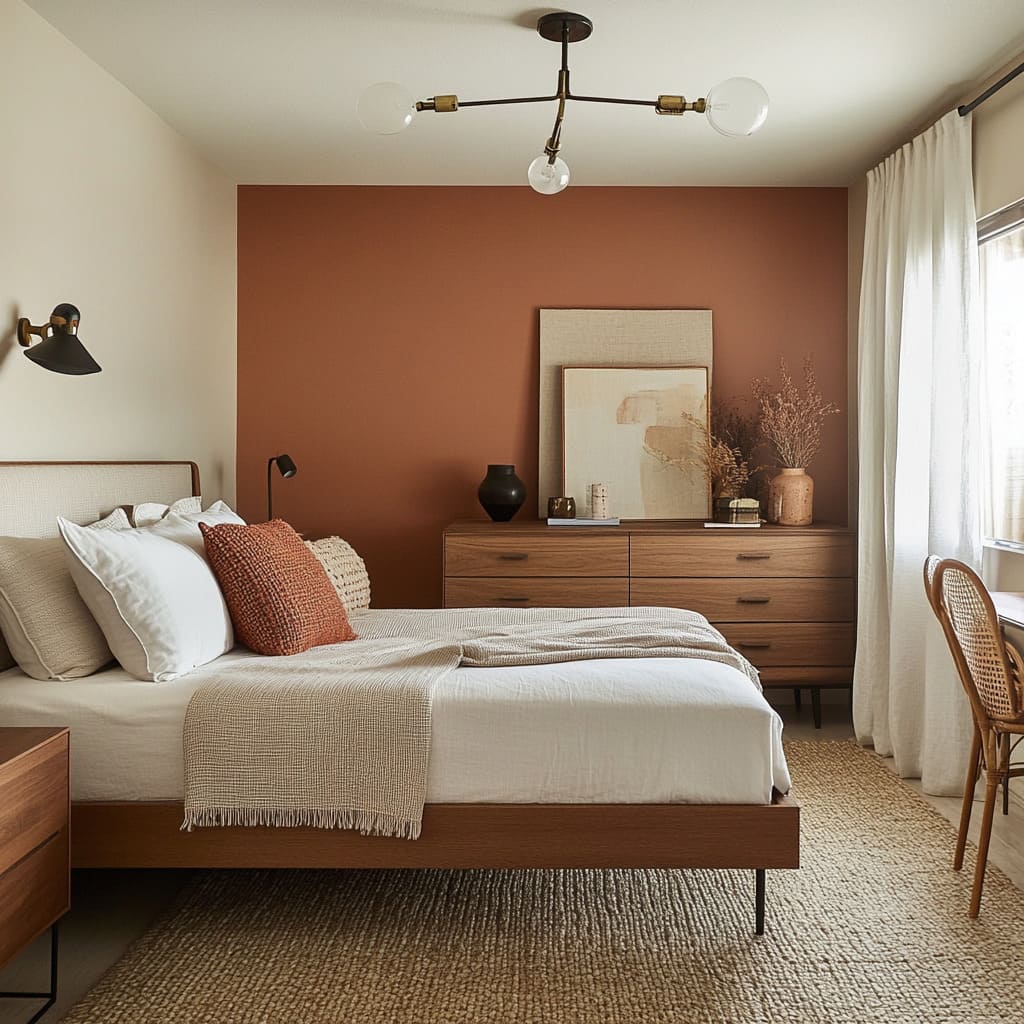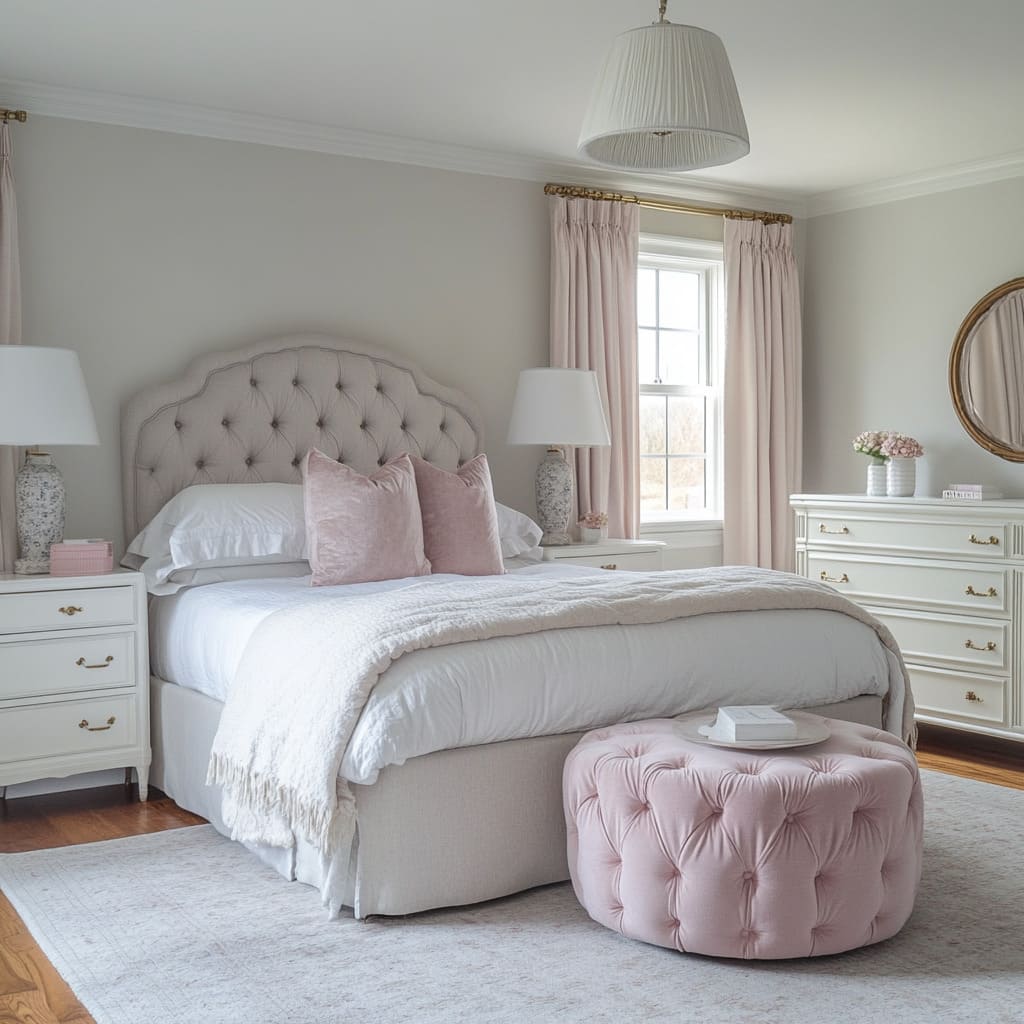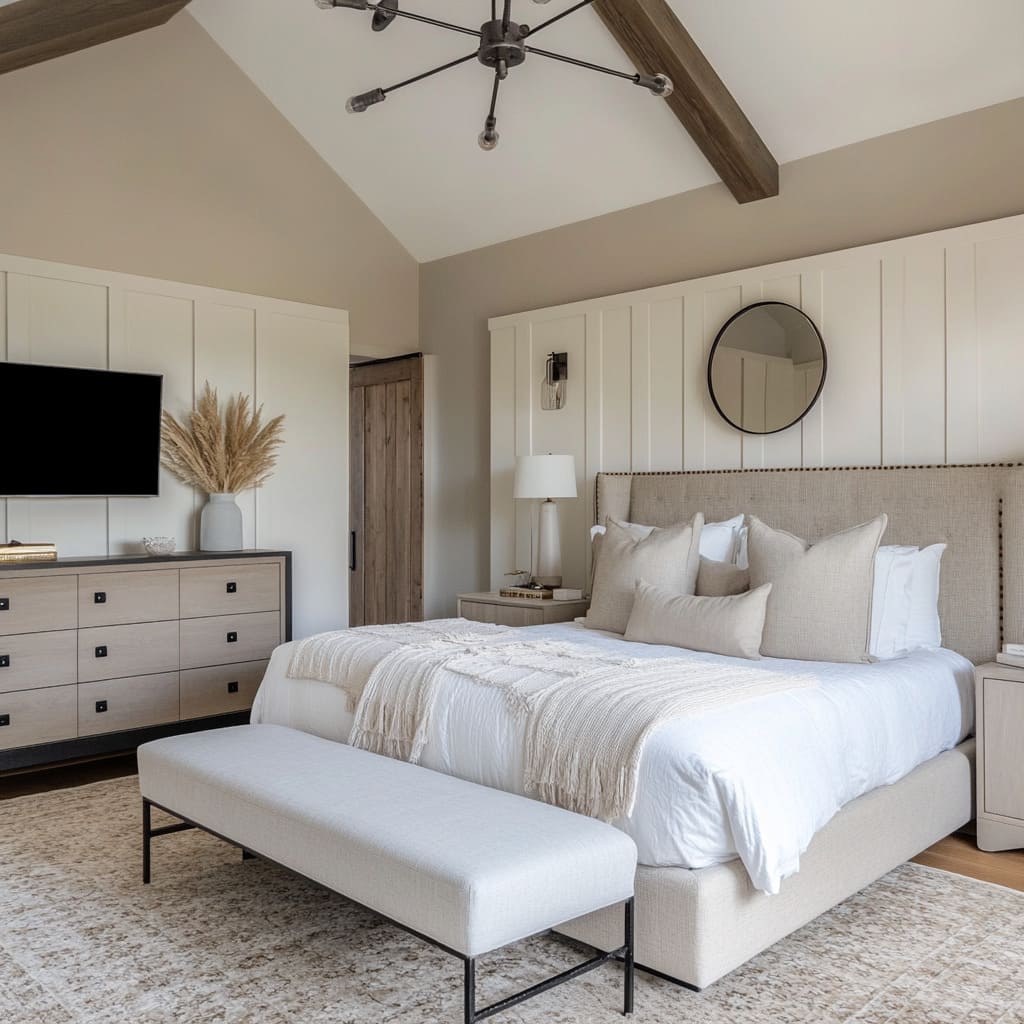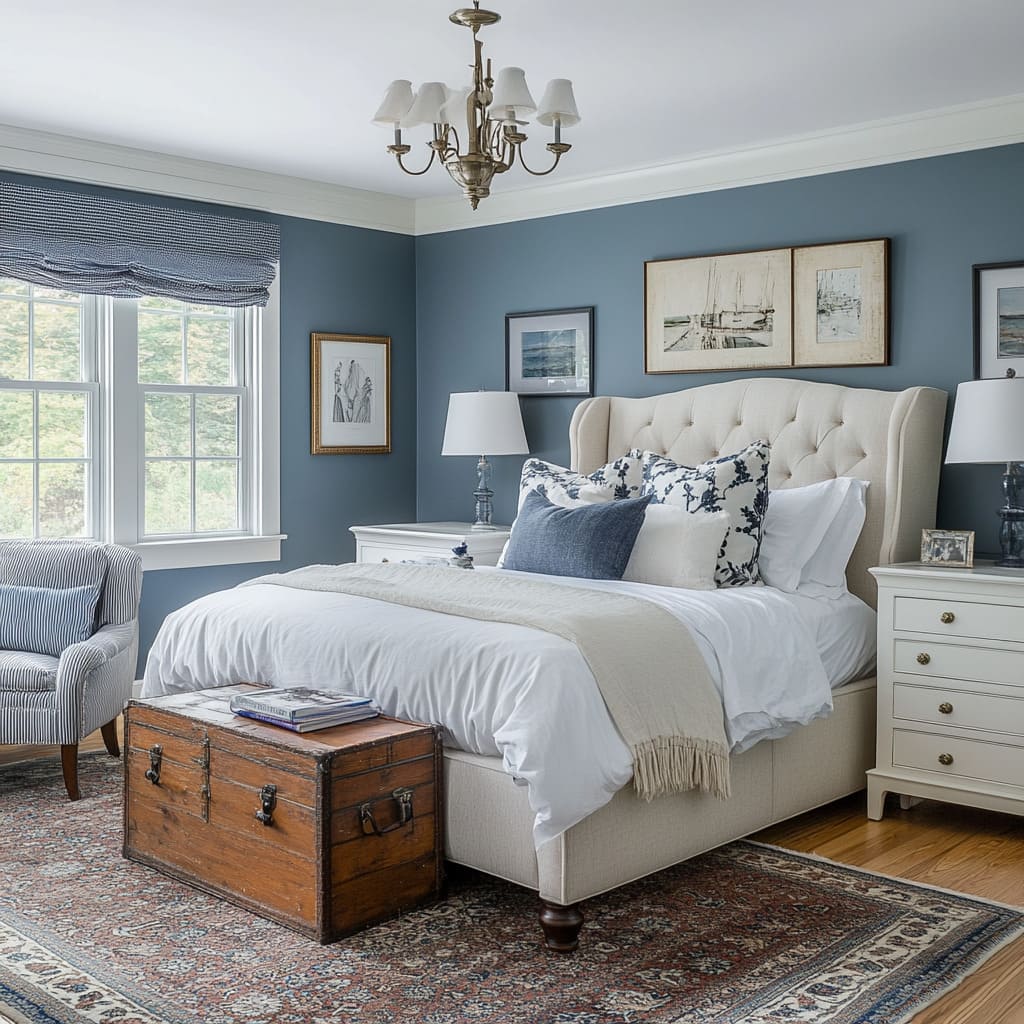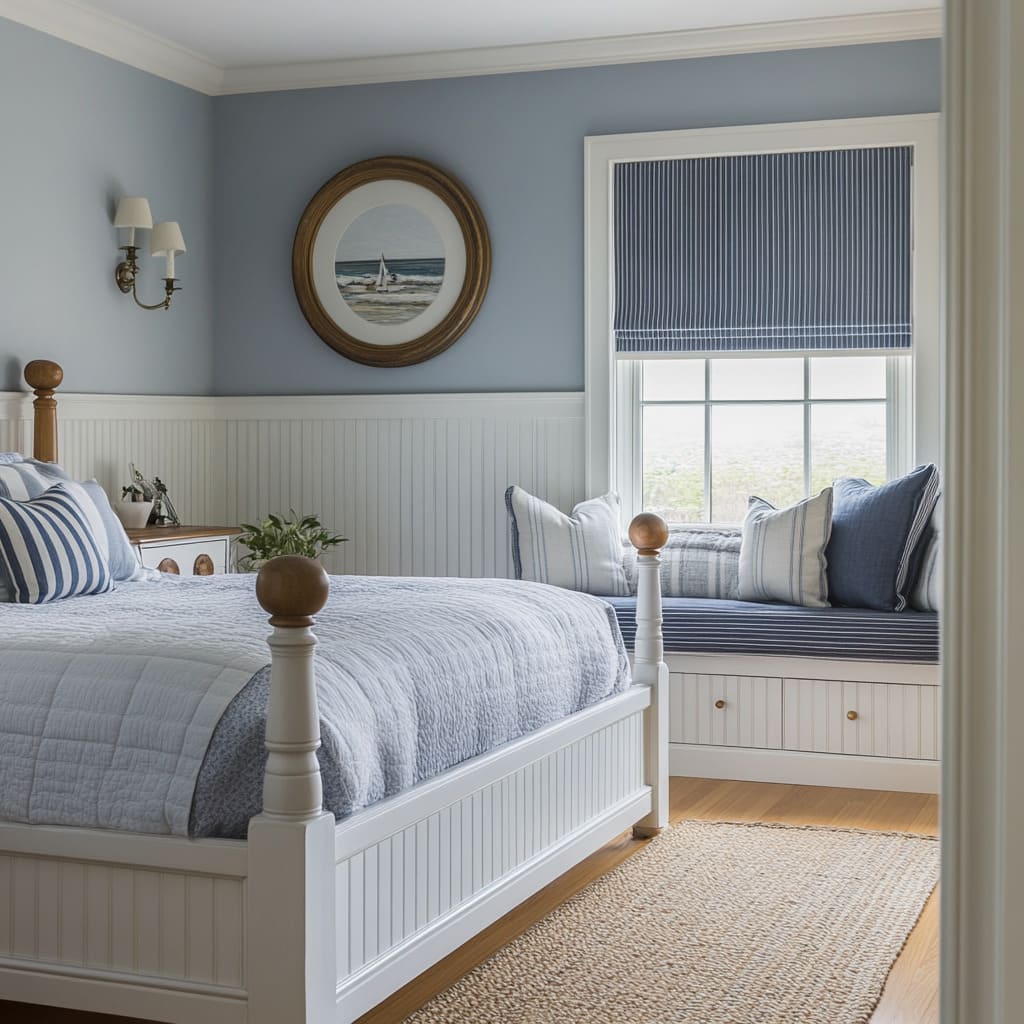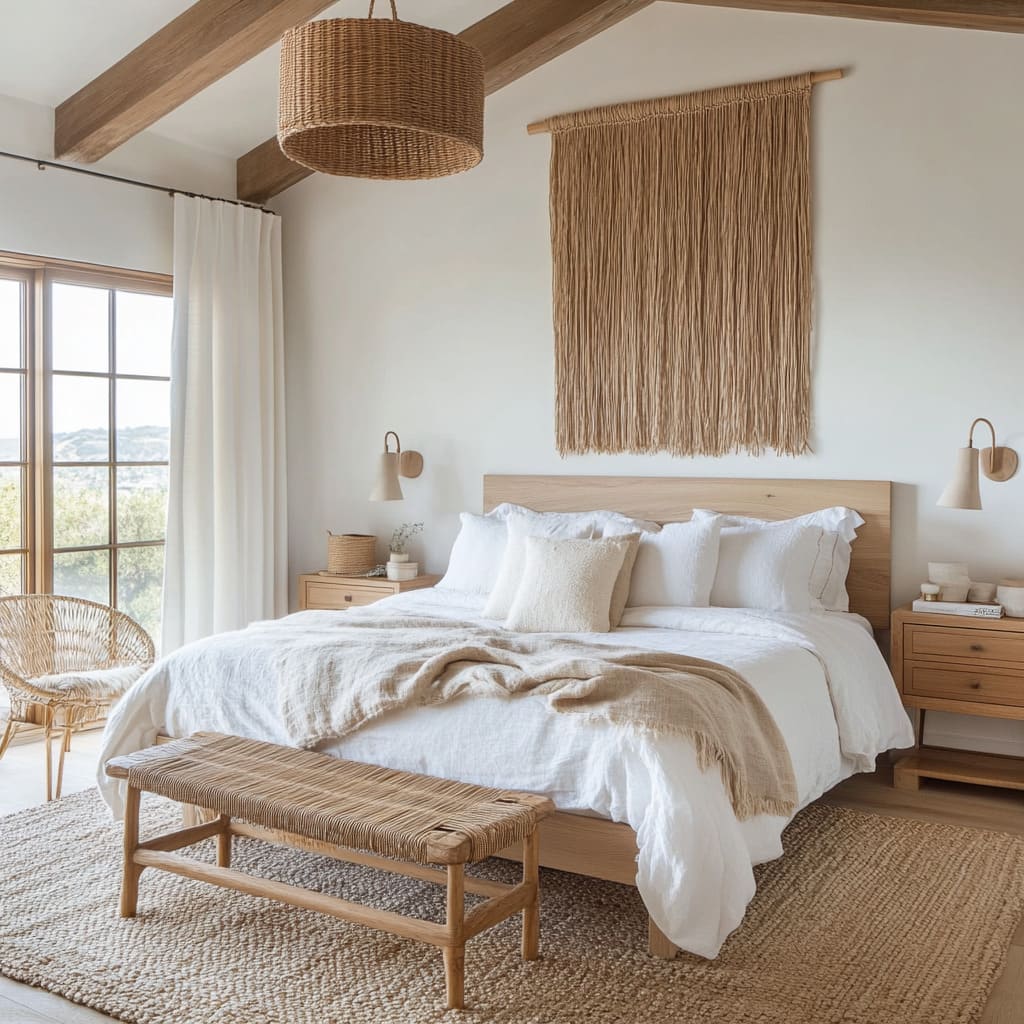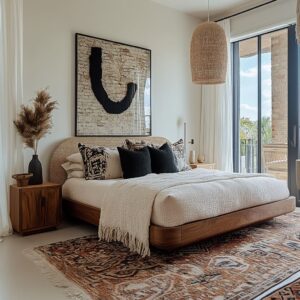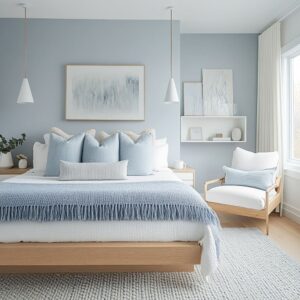Creating a stylish and practical bedroom isn’t about filling the space with expensive furniture or following fleeting trends—it’s about finding the right balance between comfort, function, and personal style. A well-designed bedroom should feel welcoming at any time of day, whether it’s for winding down at night or enjoying a slow morning with a cup of coffee.
The secret to achieving this balance often lies in subtle details: layering soft textures, choosing lighting that adjusts to different moods, and incorporating a mix of natural and structured elements. Thoughtful choices in color, furniture placement, and materials can make even the simplest spaces feel put together without looking overly decorated.
While large statement pieces like a bold headboard or oversized artwork can anchor the design, small touches—like well-placed mirrors, contrast in textiles, or even the right rug—can shift the entire feel of the room. With a few simple bedroom design ideas, it’s possible to create a space that is both stylish and functional, tailored to daily routines and relaxation.
Whether you’re working with a spacious master suite or a cozy apartment bedroom, the key is to focus on details that improve both aesthetics and practicality. In this guide, we’ll break down specific decorating techniques that can make any bedroom feel more polished, inviting, and effortlessly put together.
Textural Layering Goes Beyond the Bed
A beautifully designed bedroom isn’t just about matching colors or choosing the right furniture—it’s about layering different textures to create depth and comfort. While most people think of layering in terms of pillows, blankets, and bedding, the real magic happens when this approach extends to the entire space.
A thoughtful mix of materials on walls, floors, and ceilings makes a room feel more dynamic, cozy, and visually rich without adding unnecessary clutter.
Walls: Adding Depth and Character
Walls are often treated as a blank canvas, but they offer endless opportunities to bring in texture. Instead of relying solely on paint, consider architectural details like vertical panels, slatted wood, or shiplap.
These elements create a natural rhythm in the room, making the space feel more structured and inviting. In modern or rustic interiors, exposed brick or lime-washed plaster can bring an organic warmth, while in more classic spaces, wainscoting or beadboard adds a refined touch.
Even if you prefer the simplicity of a painted wall, a section with textured wallpaper—such as grasscloth or a subtle embossed pattern—can introduce contrast without overwhelming the space. For smaller bedrooms, a single accent wall with texture can create a striking focal point while keeping the rest of the design clean and airy.
This works especially well in urban apartments or contemporary homes where minimalism meets warmth through tactile surfaces.
Flooring: A Foundation with Layers of Comfort
Most bedrooms feature an area rug under the bed, but layering multiple rugs takes the design a step further. The combination of a larger, flatter base rug with a smaller, softer one adds dimension while enhancing comfort underfoot.
A natural fiber rug, such as jute or sisal, sets a warm, textured foundation, while a plush wool or high-pile rug on top brings softness where it matters most. This layered technique is particularly useful in open-concept spaces where the sleeping area needs subtle definition.
In a simple bedroom design, adding a contrasting rug under a reading nook or next to a dresser can break up the monotony of a single flooring type, making the space feel more intentional. In colder climates, thick rugs with layered textures help insulate the floor, creating a more inviting atmosphere during winter months.
Ceilings: The Often-Forgotten Layer
Ceilings tend to be the most overlooked surface in a bedroom, yet they play a critical role in making the space feel cohesive. Exposed wooden beams, even if decorative rather than structural, introduce a warm contrast against smooth walls.
In homes with high ceilings, a coffered or paneled design can bring a sense of intimacy, preventing the room from feeling too cavernous. For bedrooms with standard ceiling heights, subtle touches like wood trim, a thin border of contrasting paint, or even a textured plaster finish can create a similar effect.
Another trick is to extend an accent wall’s material onto the ceiling—this works particularly well with wood slats or painted paneling, drawing the eye upward and making the room feel taller.
How to Apply It in Your Own Bedroom
To get the right balance, focus on one standout texture as the main feature, such as a woven wall treatment, a chunky rug, or a slatted wood headboard. Secondary textures—like linen curtains, smooth ceramic decor, or subtle embossed wallpaper—should complement rather than compete.
If you’re mixing multiple textures, keep them in a similar color family to maintain a cohesive look. For instance, a room featuring light oak floors, beige woven fabrics, and creamy plastered walls will feel harmonious, while adding too many contrasting elements might make it feel disjointed.
The goal is to create layers that enhance the overall warmth and depth of the space, making it more inviting while keeping a sense of balance. By thinking beyond the usual pillows and blankets, you can turn a simple bedroom into a thoughtfully curated retreat where every element works together to create a relaxed, stylish, and comfortable atmosphere.
Balancing Organic and Structured Forms
A bedroom that feels visually interesting yet soothing often strikes the right balance between natural materials and structured forms. This isn’t about following rigid design rules—it’s about mixing textures and shapes in a way that makes the space feel inviting and cohesive.
Many well-designed bedrooms seamlessly combine woven furniture, earthy materials, and handcrafted details with sleek modern lines. This contrast keeps the room from feeling too predictable or overly uniform.
Woven and Handcrafted Elements: Softening the Edges
Bringing in woven furniture, basket-style lighting, or natural fiber textiles is one of the simplest ways to introduce warmth. These elements act as a counterbalance to sharper lines in a modern space, ensuring it doesn’t feel too rigid.
A rattan bench at the foot of the bed, a cane-backed chair in the corner, or a textured pendant light overhead instantly creates a relaxed atmosphere while adding depth. This approach works particularly well in rooms with clean-lined furniture.
If your space leans contemporary, with floating nightstands, a platform bed, and crisp white walls, adding handwoven decor or a seagrass rug prevents the space from feeling too stark. These organic details introduce movement and irregularity, which naturally make a room feel lived-in rather than overly curated.
Soft vs. Geometric Lines: Finding the Right Contrast
The shape of furniture and accessories plays a big role in the way a bedroom feels. A room filled with only straight edges—boxy nightstands, a square-framed bed, a rectangular mirror—can feel stiff and lacking in flow.
The same applies in reverse; too many curved pieces can make a space feel overly soft without enough structure. The best designs strike a balance between the two.
If your bed frame is angular with clean edges, consider adding rounded elements such as a circular mirror above the headboard, a soft-edged rug, or sculptural decor on the nightstand. On the other hand, if your bed has a curved or upholstered headboard, balance it with more structured furniture, like a geometric nightstand, a linear pendant light, or a rectangular bench.
A dining-style chair in a bedroom workspace with a woven seat and a solid wood frame can blend both ideas, keeping the space feeling natural but not overly casual. Many bedrooms inspired by Scandinavian or Japandi aesthetics use this contrast effectively.
While the furniture may have straight, minimalist lines, elements like boucle chairs, linen curtains, or softly textured bedspreads add just the right amount of variation.
How to Apply:
- If your room feels too sleek and cold, introduce a few organic materials—try a small rattan stool beside the bed or a handwoven basket for storing blankets.
- If you already have a softer aesthetic, introduce a structured piece, such as a rectangular floating shelf or a modern metal-framed mirror, to keep the look balanced. Pay attention to repetition—if you add a curved chair, consider echoing that form in a lamp or rug pattern to make the contrast feel intentional.
- If you’re looking for simple bedroom ideas, a good starting point is swapping out one overly structured or overly soft piece for something that contrasts with the existing furniture. Even a small adjustment, like changing a rigid rectangular mirror to a round one, can change the way a room feels.
By mixing organic materials with structured elements, you create a bedroom that feels warm and thoughtfully designed without feeling forced. This approach makes even the simplest spaces look layered and inviting, proving that contrast is often the secret ingredient to great design.
Color Contrast Used Sparingly and Strategically
Creating a well-balanced bedroom isn’t just about picking the right furniture and textures—it’s also about knowing how to use color in a way that enhances the space without overpowering it. While many modern bedrooms lean toward neutral palettes, the smartest designs use carefully placed contrasts to add depth, define areas, and bring visual interest.
The key is subtlety—too much contrast can make a space feel chaotic, while too little might leave it looking flat. Instead of filling a room with multiple bold shades, the best approach is to introduce contrast in small, deliberate ways.
Accent pillows, a statement chair, a well-placed piece of artwork, or even window trim in a darker shade can all make a difference without overwhelming the room’s overall aesthetic.
Dark Accents in a Light Room: Grounding the Space
Light-colored bedrooms often feel airy and spacious, but they can sometimes lack dimension. Adding just a few deep-toned elements can prevent a washed-out look while making the surrounding lighter shades feel brighter.
One of the easiest ways to achieve this is through textiles. A set of navy blue or forest green accent pillows on an all-white bed adds contrast without taking up any additional space.
A black-framed mirror or a deep charcoal nightstand next to a beige or off-white wall creates an anchor point, preventing the space from feeling too light and undefined. Even something as simple as a dark woven basket or a deep-toned throw blanket draped over the end of the bed can bring just the right amount of depth.
For a slightly bolder touch, consider incorporating a darker window trim or baseboards. Black or dark wood window casings in a predominantly light-colored room create a crisp, modern feel, subtly defining the edges of the space without making it feel heavy.
Light Accents in a Dark Room: Preventing a Closed-in Feeling
On the flip side, bedrooms with darker walls—such as deep blue, charcoal, or rich green—can sometimes feel smaller or overly enclosed if they lack contrast. The right light-colored accents help counteract this, reflecting existing light and creating a balanced atmosphere.
For a room with a deep wall color, white or cream-colored bedding keeps the space from feeling too heavy. Brass or brushed gold finishes on lamps, mirrors, or drawer pulls add warmth and brightness, breaking up the darker tones.
Sheer white curtains can soften the overall look while still allowing natural light to filter through. Wall art is another opportunity to add contrast.
A large, white-framed piece with soft, neutral-toned artwork provides a visual break against a dark wall, drawing attention without disrupting the overall mood. If the room features dark furniture, a lighter-colored upholstered chair or bench at the foot of the bed keeps the balance in check.
How to Apply:
- If your main palette consists of soft neutrals, start by adding contrast through small, interchangeable items like pillows or throws before committing to larger elements. A single navy accent chair, a dark wood bench, or a black metal light fixture can provide just enough variation.
- In a bedroom with dark-painted walls, be intentional with lighter elements—choose brass or cream-colored lighting fixtures, light wood furniture, or a soft area rug to prevent the space from feeling overly enclosed.
- When choosing art or decor, ensure that at least one piece stands out from the wall behind it. A dark-framed mirror on a light wall or a pale, oversized artwork on a dark wall helps create visual interest without overwhelming the space.
- If you’re looking for simple bedroom decorating ideas, a quick way to experiment with contrast is by swapping out nightstand decor or layering different-colored bedding. Even a subtle change, like adding a deep-hued lumbar pillow to an otherwise neutral bed, can shift the entire mood of the space.
By using color contrast thoughtfully, you can add richness and dimension to a bedroom while keeping the overall design balanced and inviting. Whether working with a bright, neutral palette or a darker, more intimate setting, small adjustments in color placement can make a significant impact.
Multifunctional Furniture and Zones
A well-designed bedroom should feel comfortable, stylish, and practical. Beyond simply looking good, the best spaces are arranged in a way that maximizes every inch—whether through smart furniture choices or creative use of corners and alcoves.
Many modern bedrooms blend different functions, offering seating areas, workspaces, and clever storage solutions without making the space feel cramped. By thinking beyond just a bed and nightstands, you can create a room that adapts to different needs throughout the day.
Whether it’s a bench at the foot of the bed, a cozy reading nook, or a desk that doubles as a vanity, each piece should serve a purpose while blending naturally into the design.
Seating at the Foot of the Bed: A Stylish and Functional Addition
Adding a bench or a compact stool at the foot of the bed is one of the simplest ways to increase functionality without making the room feel cluttered. Upholstered benches bring a soft, refined look and provide a convenient spot for putting on shoes or placing an extra blanket.
Woven stools or wooden benches add texture while keeping the space feeling light and airy. For larger bedrooms, a full-length bench can visually anchor the bed and make the space feel more structured.
In smaller rooms, a compact stool or a pair of low ottomans can provide the same function without overwhelming the layout. The key is choosing something proportionate—too wide, and it might disrupt movement; too small, and it may look lost in the space.
Built-In Window Seats: A Smart Use of Space
A window seat instantly transforms an underused area into a cozy and functional feature. Even a shallow ledge beneath a window can become a comfortable seating spot with the right cushion and pillows.
This setup is particularly useful in bedrooms with bay windows or alcoves, as it makes use of otherwise empty space while creating a charming nook for reading, relaxing, or simply enjoying natural light. For homes with limited storage, a window bench with built-in drawers or a lift-up seat adds hidden functionality.
This works especially well in smaller bedrooms where extra storage is needed but bulky furniture isn’t an option.
Desks and Shelves: Integrating Workspaces Without Clutter
As more people look for ways to make their bedrooms more versatile, incorporating a workspace has become increasingly common. However, a full-sized desk can easily make a bedroom feel too much like an office if not handled correctly.
The best approach is to choose a desk that blends seamlessly into the rest of the decor—one that doesn’t dominate the space but still offers enough surface area for work, reading, or even makeup application. Floating desks are a great option for simple bedroom interior design, as they take up less floor space and create a streamlined look.
Pairing a floating desk with a wall-mounted shelf above it keeps essentials within reach without adding visual clutter. For rooms that don’t have the space for a dedicated desk, consider a multipurpose nightstand—one that extends slightly wider to provide just enough room for a laptop or notebook when needed.
How to Apply:
- Identify unused areas—a corner, an alcove, or even a small space near the window—and think about how it can serve a functional purpose. A simple chair and a side table can instantly create a cozy spot for reading or relaxing.
- Scale furniture to fit the room. A large bench may look perfect in a spacious bedroom but might feel out of place in a compact one. If space is tight, opt for a stool or a slim bench that still adds function without taking up too much room.
- Think beyond traditional layouts. A desk doesn’t always need to face a wall—placing it near a window or even integrating it into an existing piece of furniture can help it feel more natural in the space.
- Keep surfaces uncluttered. Whether it’s a nightstand, desk, or built-in bench, limit the number of decorative objects to maintain a clean and calming atmosphere.
By choosing multifunctional furniture and making smart use of space, you can create a bedroom that works for both relaxation and daily life. Whether adding a reading nook, a workspace, or a simple bench at the foot of the bed, small adjustments can make a big difference in both style and functionality.
Lighting Layers for Mood and Function
Good lighting does more than just brighten a space—it shapes the entire feel of a bedroom, making it cozy, functional, and visually appealing. Many bedrooms rely on a single overhead fixture, but layering different light sources creates a more flexible and inviting atmosphere.
By combining overhead lights, wall-mounted fixtures, and softer accent lighting, you can adjust the mood based on the time of day or the activity at hand. A well-lit bedroom doesn’t just provide brightness; it enhances textures, highlights design elements, and ensures a comfortable ambiance.
Whether you want a warm, calming glow for winding down at night or bright, focused light for reading, having multiple sources allows for easy adjustments.
Wall-Mounted Fixtures: A Smart Space-Saving Solution
Traditional table lamps can take up valuable surface area on nightstands, making the space feel cluttered—especially in smaller bedrooms. Wall-mounted sconces provide the same function while keeping bedside tables free for essentials like books, a glass of water, or decorative accents.
This type of lighting works particularly well in modern and minimalist spaces, where clean lines and open surfaces contribute to a streamlined look. Whether you opt for sleek metal sconces, vintage-inspired fixtures, or adjustable swing-arm lamps, these lights can be both functional and decorative.
For those who love symmetry, installing matching sconces on either side of the bed creates a polished, hotel-like appearance. If a room has a more relaxed feel, an asymmetrical setup—such as one sconce paired with a pendant light on the other side—adds personality without disrupting the flow of the space.
Pendants Over Nightstands: A Stylish Alternative
Hanging pendant lights beside the bed is another way to keep nightstands clear while adding a unique design element. This approach works especially well in bedrooms with high ceilings, where the extra vertical space allows for longer, statement-making fixtures.
Pendants come in endless styles, from sleek glass designs to woven rattan shades that bring in natural texture. Choosing a pendant with a warm-toned bulb ensures a soft, diffused glow, making the space feel inviting rather than overly bright.
Height matters when installing bedside pendants. Ideally, the light should hang at a level where it’s easy to reach from the bed but doesn’t block the line of sight.
A good rule of thumb is placing the bottom of the pendant around 12–18 inches above the nightstand surface.
Accent Lighting: Soft Glow Without Harshness
For an extra layer of warmth, subtle accent lighting can make a big difference. LED strips placed behind a headboard, under a floating bed frame, or inside a cove ceiling provide a soft, indirect glow that enhances depth and makes the space feel more inviting.
This is particularly useful for those who want a modern look without relying on bright, direct lighting. Accent lighting is also practical—it creates enough illumination for nighttime movement without disturbing the rest of the room.
For example, motion-activated LED strips under the bed provide a gentle path of light for getting up at night without needing to turn on overhead fixtures.
How to Apply:
- Start with a central light source, like a ceiling pendant, chandelier, or fan with an integrated light. This ensures general brightness when needed.Layer in
- ask lighting by adding sconces, pendants, or table lamps. If you read or work in bed, adjustable fixtures that direct light where needed are ideal.
- Use accent lighting to introduce warmth. Whether it’s a hidden LED strip behind a headboard or a softly glowing floor lamp in the corner, these small details can completely change the atmosphere.
- Install dimmers on overhead lights whenever possible. Being able to control brightness levels helps create the right ambiance, whether you want soft lighting for relaxation or full brightness for getting ready in the morning.
For those looking for simple master bedroom ideas, starting with thoughtful lighting choices is a game-changer. Instead of relying on a single fixture, incorporating layers of light allows you to shift the mood effortlessly, making the space feel more polished, functional, and inviting.
The Impact of Personal Art and Decor
The right artwork and decor can completely transform a bedroom, making it feel curated and intentional rather than just a collection of furniture and textiles. Art isn’t just a finishing touch—it plays a key role in setting the tone of the space, adding color, texture, and personality.
Whether you prefer subtle, coordinated pieces or bold, statement-making artwork, the way you integrate decor into your bedroom can change how the entire space feels. A well-placed painting, framed print, or sculptural decor piece can either blend seamlessly with the room’s palette or introduce a striking contrast.
Mirrors, another underutilized decor element, can enhance light and make a room feel more expansive while serving as a stylish focal point.
Subtle Artwork: Seamless Integration
For bedrooms designed with a calming, neutral palette, artwork can be a natural extension of the space rather than a dramatic contrast. Large-scale abstract pieces in soft, muted tones—beige, soft blues, warm greys—add depth without overwhelming the design.
Textured canvases, simple line drawings, or minimalist photography work well in these setups, reinforcing the relaxing nature of the room while adding visual interest. This approach works particularly well in minimalist, Scandinavian, or Japandi-inspired bedrooms, where the goal is to maintain a sense of balance without too much visual clutter.
If the artwork closely follows the wall color, it creates an understated, sophisticated effect that enhances the space without demanding too much attention.
Statement Artwork: A Bold Focal Point
If your bedroom leans toward a more restrained design—think neutral bedding, simple furniture, and soft lighting—a striking art piece can instantly introduce energy and personality. Deep, moody hues, contrasting colors, or abstract compositions with bold brushstrokes can serve as a visual anchor, drawing the eye and preventing the space from feeling too uniform.
A single oversized painting above the bed can be enough to establish a focal point, especially if the rest of the room follows a neutral or monochromatic palette. Alternatively, a curated gallery wall featuring a mix of different art styles, framed prints, and small sculptural elements can bring character without overwhelming the space.
For those hesitant about strong colors, black-and-white artwork with dynamic, expressive lines can provide contrast while still feeling refined. Framed sketches, ink drawings, or abstract monochrome pieces are excellent for adding drama in a controlled way.
Mirrors: More Than Just Reflection
Mirrors are one of the most versatile decor elements in a bedroom. Beyond their practical use, they enhance light, create the illusion of more space, and can even function as a central design feature.
When placed strategically, mirrors bounce natural light around the room, making it feel brighter and more open.
- Above the nightstands: A pair of matching mirrors can replace traditional wall art, bringing symmetry while reflecting light from nearby lamps.
- Opposite a window: This placement maximizes natural light, making the room feel larger and more airy.
- Leaning against a wall: A full-length mirror in a stylish frame, propped against a wall, adds a relaxed, effortless touch while enhancing depth in the space.
- Framed as a centerpiece: Unconventional mirror designs—such as round, arched, or uniquely shaped frames—can act as sculptural elements, adding interest to a bedroom’s decor.
For smaller rooms, mirrors can help break up blank walls without the need for heavy artwork, keeping the space feeling light and open.
How to Apply This in Your Own Bedroom
- Let the existing palette guide your choices. If your walls, bedding, and furniture follow a neutral scheme, consider introducing a bold color through artwork for contrast. On the other hand, if your space already features deep tones, a soft-hued or neutral art piece can maintain balance.
- Think about scale. Large blank walls often need substantial artwork to avoid feeling empty, while smaller walls benefit from more delicate or layered pieces. If using a gallery-style arrangement, keep spacing consistent to maintain a cohesive look.
- Choose multi-purpose decor. If you want to maximize function, consider a mirror with a decorative frame or an art piece that ties into other design elements, such as textured fabric panels or sculptural lighting.
- Experiment with placement. Artwork doesn’t always need to be centered or perfectly aligned—off-center arrangements, layered leaning frames, or mixed media elements can create a more dynamic effect.
If you’re looking for basic bedroom decorating ideas, starting with art and decor is one of the easiest ways to refresh a space without making major furniture changes. A single well-placed piece, whether a framed print, a bold canvas, or a uniquely shaped mirror, can shift the entire mood of the room while reflecting your personal style.
Choosing and Arranging Rugs for Warmth
A well-chosen rug does more than just soften the floor—it plays a major role in defining space, adding texture, and enhancing comfort. The right placement can make a room feel more balanced, while the right material choice brings warmth and depth to the design.
Whether your bedroom leans toward a modern, minimalist look or a layered, cozy aesthetic, rugs help bring everything together in a way that feels intentional rather than an afterthought. One of the biggest mistakes people make is selecting a rug that’s too small or placing it in a way that doesn’t properly anchor the furniture.
A rug should visually and physically connect the main elements in the room, rather than just floating under the bed with no clear purpose.
Under Bed Placement: Creating a Soft Landing
The most common and practical way to position a rug in a bedroom is under the bed, ensuring that at least the front legs of the bed and nightstands rest on it. This setup visually anchors the sleeping area while adding softness underfoot when getting in and out of bed.
For larger rooms, a generously sized rug that extends beyond the bed’s sides and foot creates a more cohesive look. In compact spaces where a full-size rug might feel overwhelming, a smaller option placed only at the lower half of the bed can still define the sleep area while allowing the flooring to remain visible.
For a queen-size bed, an 8’x10’ rug generally works well, while a king-size bed benefits from a 9’x12’ option to ensure proper coverage. If using runners instead of a full rug, placing them along both sides of the bed adds a soft touch without overpowering the space.
Layering and Pattern Mixing: Adding Dimension
A simple way to introduce depth is by layering rugs—especially if you have a neutral base and want to add a bit of pattern or texture. A large jute or sisal rug as the foundation paired with a smaller vintage or patterned rug on top creates a rich, layered look without making the space feel too busy.
This approach works particularly well in bedrooms with a simple color scheme. The base rug keeps the space grounded, while the top layer adds personality and contrast.
If the bed and furniture are fairly neutral, a patterned or textured rug introduces movement without overwhelming the decor. When mixing patterns, the key is keeping at least one element consistent—either a common color palette or a similar texture—to prevent clashing.
For instance, a muted Persian-style rug over a woven natural fiber base can work beautifully if both share complementary warm tones.
Material Selection: Balancing Comfort and Function
Rug materials play a big role in the feel of a bedroom. Natural fiber options like jute and sisal bring an organic, textured look that pairs well with rustic or coastal-inspired spaces.
While these materials add character, they tend to be rougher underfoot—so if comfort is a priority, layering a plush rug on top can provide the best of both worlds. For cooler climates, wool rugs offer a soft, insulating feel that adds warmth in the winter months.
They’re durable and naturally stain-resistant, making them a great long-term investment. Cotton rugs, while lightweight and easy to clean, work well in casual settings but might not provide the same level of coziness as wool.
High-pile rugs or shag styles add an extra layer of softness, perfect for bedrooms where comfort is key. However, they require more maintenance and may not be the best choice for high-traffic areas.
How to Apply:
- Ensure the rug size matches the space. A rug that’s too small can make the room feel disconnected, while an oversized one can overpower the layout. Aim for at least the front legs of the bed to rest on the rug for a balanced look.
- Use layering to introduce depth. A neutral jute or wool base rug can be paired with a smaller patterned rug for added dimension without overwhelming the design.
- Pick a material that suits your needs. For a low-maintenance option, natural fibers like jute work well. If warmth and softness are the priority, wool or high-pile rugs are the better choice.
- Consider placement beyond just under the bed. Runners along the sides of the bed or a small statement rug near a reading nook can add texture while enhancing comfort.
For those looking for bedroom design simple ideas, starting with the right rug can redefine the entire space. Whether using it to frame the bed, soften the flooring, or introduce an extra layer of warmth, a well-placed rug adds both style and function without requiring a full room makeover.
Make Use of Vertical Space
Maximizing vertical space is one of the simplest ways to make a bedroom feel more open and thoughtfully designed. Whether through tall curtains, stacked shelving, or vertical artwork, the right approach can add height to a room without requiring structural changes.
This technique is particularly effective in compact bedrooms, where every inch counts, but it also enhances larger spaces by drawing attention upward, creating a more balanced design. Bedrooms that incorporate floor-to-ceiling elements naturally feel more spacious and cohesive.
Even in rooms with standard-height ceilings, small adjustments—like placing curtain rods higher or using tall bookcases—can change the perception of space.
Floor-to-Ceiling Curtains: Creating Height
Hanging curtains at ceiling level is one of the easiest tricks to make a room appear taller. Even if the windows aren’t particularly large, extending the fabric beyond the window frame guides the eye upward, giving the illusion of more height.
To achieve the best effect, choose curtain panels that reach the floor, avoiding ones that stop short. If space allows, letting curtains gently pool on the ground adds a touch of softness.
Light, airy fabrics like linen or sheer panels work well for a relaxed look, while heavier materials like velvet or blackout drapes create a more structured appearance. For a seamless effect, extend the curtain rod beyond the edges of the window frame as well.
This allows more natural light to enter when the curtains are drawn open and makes the window appear wider.
Built-In Vertical Shelving: Storage with Impact
For those who need additional storage without cluttering the floor, built-in shelving that stretches upward can be both functional and visually striking. Open shelving around the bed or along a side wall adds depth to the design while providing a convenient place for books, decorative objects, and storage baskets.
In smaller homes or apartments, tall shelves can help make use of otherwise empty wall space. Floating shelves above a headboard can act as a design feature while serving a practical purpose, holding framed art, lamps, or small accessories.
For a cleaner look, keeping shelves in a similar color to the walls prevents them from feeling too heavy in the space. If built-ins aren’t an option, consider modular shelving units that extend upward rather than outward.
Slim, ladder-style bookcases or vertical cabinets can help frame a room without taking up too much square footage.
Artwork and Mirrors: Playing with Proportions
Vertical art pieces or mirrors are another way to subtly enhance the sense of height in a bedroom. Instead of wide, horizontal frames, choosing tall and narrow artwork helps elongate the walls.
This works particularly well above nightstands, between windows, or even as a centerpiece above the bed. Mirrors, especially when placed opposite a window or light source, reflect natural light and add depth to the space.
A slender floor mirror leaning against a wall can make a bedroom feel larger without requiring installation, while a vertical mirror above a dresser or desk keeps the look streamlined. For those working with a more traditional layout, a symmetrical arrangement—such as two vertical art pieces flanking a bed—adds balance while subtly reinforcing height.
How to Apply This in Your Own Bedroom
- Hang curtain rods higher than the window frame to create the illusion of taller ceilings. Even an extra 6–12 inches makes a difference.
- Use vertical shelving to make the most of empty wall space, whether with built-ins, floating shelves, or tall bookcases.
- Choose art and mirrors with an elongated shape to subtly stretch the perception of height in the room.
- Keep colors cohesive when incorporating tall storage units or shelving to maintain an airy, uncluttered look.
For those searching for bedroom design simple ideas, focusing on vertical space is an easy way to upgrade the room without major renovations. Whether through taller furniture, layered curtains, or thoughtful placement of decor, these adjustments make a space feel polished, well-proportioned, and effortlessly inviting.
Coordination of Furniture Finishes
A well-designed bedroom isn’t just about selecting stylish furniture—it’s about making sure each piece works together to create a cohesive look. While some people assume all wood tones and metal finishes must match perfectly, mixing different shades and textures can add depth and character when done thoughtfully.
Successful coordination comes down to balance. A room where every furniture piece is an exact match can feel overly uniform, while too many competing finishes can make the space feel unstructured.
Finding a middle ground—where different materials complement each other rather than clash—is the key to creating a layered yet polished aesthetic.
Mixing Wood Tones Without Clashing
There’s no need to stick to a single wood finish throughout the entire bedroom. A dark walnut bed frame can pair beautifully with honey-toned oak nightstands, as long as there’s some consistency in the overall style.
The trick is to keep the wood tones within the same warmth—either warm shades like cherry and mahogany or cooler tones like ash and grey-washed oak. If the wood finishes are noticeably different, repeating a shared texture or grain pattern can tie them together.
For example, if a dresser and nightstand are in different wood tones, a headboard or floating shelf that incorporates both shades can create a sense of balance. Another way to make mixed wood tones work is by introducing a neutral buffer, such as a fabric-upholstered bed or painted nightstands.
These elements help soften transitions between contrasting finishes, ensuring that nothing feels out of place.
Repetition of Accents for a Unified Look
While wood tones can vary, metal accents should generally be more consistent. Mixing too many different metallic finishes can make a space feel scattered, but using one or two complementary shades helps unify the design.
For instance, if a bedroom features black sconce lights, choosing black drawer handles and picture frames reinforces that color subtly throughout the room. Similarly, if brass accents are used on lamp bases, repeating that finish in curtain rods or mirror frames creates a deliberate, connected look.
If a room naturally incorporates both cool and warm metals—such as chrome and gold—one way to balance them is through a third, neutral element, like matte black. Black hardware or light fixtures can serve as a grounding force that keeps the different metallic tones from feeling disconnected.
How to Apply
- Stick to a consistent warmth in wood finishes. If your bed frame is warm-toned wood, keep nightstands and dressers in similar shades, even if the exact stain differs.
- Use repetition to create flow. If your lamp bases are brass, echo that finish in drawer pulls or mirror frames. This small detail makes the space feel intentionally designed.
- Break up mismatched woods with neutral furniture. A white or fabric-upholstered bed can act as a visual bridge between contrasting wood tones.
- Limit metal finishes to one or two tones. Too many variations can create visual clutter, while selective repetition keeps everything balanced.
Coordinating furniture finishes doesn’t mean everything has to match—it’s about creating connections between different elements so the space feels curated rather than random. With the right mix of wood tones and well-placed metallic details, a bedroom can feel effortlessly put together while maintaining personality and warmth.
Adding Plants and Botanical Touches
Bringing greenery into a bedroom is one of the simplest ways to soften a space and make it feel more inviting. Whether it’s a large potted plant in the corner, a few small succulents on a nightstand, or a vase filled with fresh branches, natural elements add warmth and texture without overwhelming the design.
The presence of plants not only enhances the aesthetic appeal of a bedroom but can also improve air quality and create a sense of calm. Even in rooms with limited natural light, there are options to incorporate greenery without the upkeep of high-maintenance plants.
Large Statement Plants: Adding Structure and Height
A tall plant in the corner of a bedroom does more than just add greenery—it introduces height and softens the hard lines of furniture. This is particularly effective in rooms with minimal decor, where a well-placed plant can act as a design element on its own.
Fiddle leaf figs, rubber trees, or bird of paradise plants thrive in bright, indirect light and make a strong visual impact. In rooms with lower light, snake plants or ZZ plants are excellent alternatives, requiring little maintenance while still bringing a touch of nature indoors.
For a cleaner, modern aesthetic, a sleek pot in a neutral tone allows the greenery to stand out without competing with the rest of the decor. In a more relaxed or bohemian setting, woven baskets or textured planters can complement natural materials in the room.
Dried Botanicals: Low-Maintenance Greenery
For those who love the organic look of plants but don’t want the responsibility of watering, dried florals and pampas grass are effortless alternatives. These elements introduce movement and texture while maintaining a soft, neutral presence that works well in almost any bedroom style.
A simple bundle of pampas grass in a ceramic vase adds a sculptural quality to a dresser or nightstand. Eucalyptus stems, whether fresh or dried, provide a subtle fragrance and a delicate touch when placed in a minimalist vase.
Unlike live plants, dried botanicals require no upkeep, making them ideal for bedrooms that don’t receive much natural light.
Flowers and Branches: A Simple Yet Impactful Touch
For a rotating seasonal update, fresh flowers or branches in a vase can change the feel of a space without a long-term commitment. A clear glass or stoneware vase filled with cherry blossoms in spring, olive branches in summer, or dried maple leaves in fall keeps the room feeling fresh and in tune with the seasons.
In more neutral spaces, bold-colored flowers can add a striking contrast, while in richly colored rooms, simple white or green arrangements keep things balanced. Keeping florals minimal—such as a single stem in a narrow vase—works well for those who prefer a refined, understated look.
How to Apply This in Your Own Bedroom
- Use a large statement plant in an empty corner to introduce height and soften sharp furniture edges.
- Opt for low-maintenance greenery like snake plants or pothos if natural light is limited.
- Incorporate dried botanicals for texture without the need for watering.
- Switch out fresh flowers or branches seasonally for an easy way to refresh the space.
- Keep plant containers simple and cohesive—neutral pots, woven baskets, or ceramic vases can complement different bedroom styles without competing with other decor.
For those searching for simplistic bedroom ideas, adding plants is an effortless way to create a more inviting atmosphere. Whether real or dried, greenery brings life to a room while complementing a variety of design styles, from modern minimalism to cozy traditional spaces.
Practical Steps for Your Own Bedroom
Creating a stylish and comfortable bedroom isn’t just about picking furniture and decor—it’s about making sure every choice works together in a way that feels natural and inviting. With a few thoughtful steps, you can pull together a space that looks polished without feeling overdone.
Identify Your Focal Points
Every bedroom needs a visual anchor, and in most cases, that’s the bed. Whether it’s a bold headboard, an accent wall, or a unique lighting arrangement, having one main feature makes the design feel intentional.
Once you decide on this focal area, the surrounding furniture and decor should complement it rather than compete for attention. For example, if the headboard is upholstered in a rich fabric, the nightstands and lamps should be more understated so they don’t overpower the centerpiece.
On the other hand, if the walls are kept simple, a dramatic chandelier or sculptural pendant light can take center stage without making the room feel crowded.
Plan Your Textures and Colors First
A well-designed bedroom starts with a clear vision. Before buying individual pieces, decide on a color palette with two or three main hues and a few key materials.
This step ensures the space looks balanced rather than feeling like a mix of random elements. For a softer atmosphere, consider warm neutrals paired with natural materials like linen and wood.
If you prefer a more modern contrast, darker tones with metallic finishes can create a refined look. Keeping the palette cohesive makes layering easier and prevents the space from feeling chaotic.
Balance Large and Small Details
A room feels more complete when there’s a mix of grand statement pieces and smaller finishing touches. A striking chandelier, a feature wall, or a large piece of art can guide the eye, but the details—like textured throw pillows, well-chosen vases, or decorative books—bring the design together.
Think of it like layering an outfit: the bold elements catch attention, but the smaller details refine the overall look. Even in a minimalist space, subtle accents add warmth and character without overwhelming the simplicity of the design.
Use Lighting to Shift the Mood
Good lighting isn’t just about brightness—it’s about flexibility. Instead of relying on a single overhead light, incorporating multiple layers creates a more adaptable space.
- Overhead fixtures provide general illumination but should be paired with softer lighting options.
- Bedside lamps or sconces offer direct lighting for reading or winding down in the evening.
- Accent lighting, like LED strips or picture lights, adds warmth and can highlight specific areas of the room.
For even more control, dimmable bulbs or smart lighting systems let you adjust brightness levels throughout the day. This flexibility ensures the space can transition seamlessly from a functional morning setup to a cozy retreat at night.
Adjust and Edit for Balance
Once all the furniture and decor are in place, take a step back and assess how the room feels. If an area looks too busy, removing one or two pieces can improve the overall balance.
A well-designed bedroom isn’t about filling every inch—it’s about creating a space that feels open and inviting. Leaving some breathing room around furniture prevents the layout from feeling cramped.
Even in smaller spaces, choosing pieces with clean lines and avoiding unnecessary clutter can make the room feel more spacious. For those looking for simple ideas for decorating a bedroom, focusing on focal points, color consistency, and layering textures ensures that the space feels thoughtful and visually appealing.
With a clear plan and a few well-placed adjustments, a bedroom can become a comfortable and stylish retreat that feels effortlessly put together.
Key Observations Worth Remembering
A well-designed bedroom is a balance of contrast, proportion, and comfort. While aesthetics matter, the most inviting spaces feel intentional and practical at the same time.
Here are some essential takeaways to keep in mind when refining your space.
Contrast and Uniformity: Avoiding a Flat Look
A bedroom where everything matches too closely—whether all-white furniture, identical wood tones, or a monochrome color scheme—can feel static. While uniformity creates cohesion, it’s the small contrasts that add depth.
The easiest way to introduce contrast without overwhelming the space is through accent pillows, statement lighting, or even a single focal wall. A dark trim around a window, a boldly framed mirror, or textured fabrics in a slightly deeper tone than the walls can prevent the room from looking one-dimensional.
The goal is balance—enough contrast to create interest without disrupting the sense of harmony.
Practical Comfort: Seating That Works Beyond Aesthetics
Adding a decorative bench at the foot of the bed or an accent chair in the corner isn’t just about filling space—it’s about function. These elements provide a place to sit when getting dressed, a spot to stack folded clothes temporarily, or even an extra surface for a book or blanket.
Instead of treating extra seating as an afterthought, consider how it fits into the overall flow of the room. A woven bench with a cushion can soften a minimalist space, while a plush upholstered stool adds a sense of coziness to more traditional designs.
The key is choosing something that feels useful without taking up too much room.
Proportion and Scale: Matching Furniture to the Space
The wrong proportions can make even the most thoughtfully designed room feel off. A towering bed with tiny nightstands creates imbalance, just as a platform bed might feel visually lost next to oversized dressers or bulky lamps.
To maintain proper scale:.
- If the bed has a tall headboard, choose nightstands that are at least at mattress height, paired with lamps that don’t feel dwarfed by the furniture.
- For a lower-profile bed, keep side tables sleek and proportional, opting for wall-mounted sconces if tabletop space is limited.
- Rugs should extend beyond the bed’s edges to feel intentional rather than an afterthought. A rug that’s too small can make a room feel fragmented, while a well-sized one grounds the space.
Color Psychology: Setting the Right Mood
The colors in a bedroom do more than just look good—they influence how the space feels. Muted greens and soft blues are known for their calming effect, making them great choices for walls, bedding, or even upholstered furniture.
Warm earth tones like terracotta, caramel, and deep beige create a more cocoon-like atmosphere, perfect for those who prefer a cozy, grounded feel. For those who love a neutral space but still want personality, subtle shifts in undertones—warm beige instead of stark white, or a pale sage instead of gray—can make the space feel layered rather than sterile.
Organic Touches and Material Harmony
Natural textures have a way of making a bedroom feel more inviting. From linen bedding to rattan light fixtures, raw wood nightstands, or woven rugs, these elements bring warmth and softness without adding clutter.
Keeping natural materials in a similar color range ensures they feel cohesive. A light oak bed frame pairs beautifully with neutral jute rugs and off-white linen curtains, while darker walnut furniture works well with leather or deep-toned woven baskets.
The key is to let these textures add richness without making the space feel too busy.
Final Thoughts
A stylish and practical bedroom isn’t about one single dramatic feature—it’s about layering the right elements in a way that feels intentional. The best spaces consider everything from the floor to the ceiling, blending lighting, textures, and functional decor to create a room that feels just right.
Whether it’s introducing contrast, choosing furniture that fits the space, or selecting materials that bring warmth, the details matter. A well-thought-out bedroom isn’t just for sleeping—it becomes a retreat that reflects both comfort and personal style.
